Form 8-K Krystal Biotech, Inc. For: Nov 09
Exhibit 99.1

Krystal Biotech Reports Third Quarter 2020 Financial Results and Provides Update on Operational Progress
- Pivotal GEM-3 study of B-VEC in DEB expected to complete enrollment in early 2021
- Initiated the Phase 1 Study of KB301 in Facial Wrinkles and Acne Scars
- Today announced additional in vivo preclinical data supporting the development of KB407 in cystic fibrosis
- Strong balance sheet with cash, cash equivalents and short-term investments of $286.4 million as of September 30, 2020
-
PITTSBURGH, November 9, 2020 – Krystal Biotech, Inc. (Nasdaq: KRYS), a fully integrated gene therapy company driven by its proprietary, engineered herpes simplex virus type 1 vector (HSV-1) platform, today reported financial results and key operational progress updates for the third quarter ended September 30, 2020.
“Despite the challenges presented by COVID in this quarter, we initiated a pivotal trial for DEB, a phase 2 trial in ARCI and a phase 1 trial in aesthetic skin conditions, and I thank my entire team for their efforts in these difficult times,” said Krish Krishnan, Chairman and CEO of Krystal Biotech, Inc. “I am particularly encouraged by progress with KB407 for the treatment of cystic fibrosis. The in vivo animal data reported today demonstrates our ability to deliver functional CFTR throughout the lung, which is encouraging in this indication and gives us confidence to explore additional diseases of the lung where delivery of a therapeutic transgene may be beneficial.” he added.
He further noted “With the granting of Rare Pediatric Designation for this program by the FDA this quarter, we are now eligible to receive a Priority Review Voucher for KB407 as well as for B-VEC, KB105, KB104.”
Program Highlights & Upcoming Events
Beremagene Geperpavec (B-VEC) for DEB
| - | Enrollment in the ongoing pivotal GEM-3 study is proceeding well and enrollment completion is anticipated in early 2021. The trial is a randomized, double-blind, intra patient placebo-controlled multicenter trial designed to evaluate the efficacy and safety of B-VEC for patients suffering from both recessive and dominant dystrophic forms of Epidermolysis Bullosa. |

| - | Details of the pivotal study can be found at www.clinicaltrials.gov under NCT identifier NCT04491604. |
| - | Top line data and BLA filing are anticipated in 2021, in line with prior guidance. Data from this trial will also form the basis of an MAA filing in the EU which is anticipated to occur shortly after the BLA filing. |
KB105 for TGM1-ARCI
| - | In September 2020, preclinical data supporting the development of KB105 in TGM1-related Autosomal Recessive Congenital Ichthyosis (ARCI) were published online ahead of print in the peer-reviewed Journal of Investigative Dermatology. |
| - | Dosing of the 4th patient in the Phase 1/2 study of KB105 in patients with TGM1 deficient autosomal recessive congenital ichthyosis (ARCI) has completed. Treatment of a larger area and therefore higher dose is being evaluated. Data from this patient together with the data from the 3 initial patients, will help determine next steps. |
| - | Details of the Phase 2 study can be found at www.clinicaltrials.gov under NCT identifier NCT04047732. |
| - | The Company plans to present an update on this program in the first half of 2021. |
KB407 for Cystic Fibrosis
| - | New in vivo data from the ongoing preclinical development of KB407 shows successful nebulization, distribution of vector and functional protein expression throughout the lung in mice and a nonhuman primate. More detailed results are available in a corporate presentation available under the Investors section of our website, here. |
| - | In September 2020, KB407 was granted Rare Pediatric Designation by the FDA. |
| - | During the third quarter of 2020, we received a Notice of Allowance for our patent application covering methods of using KB407 for the treatment of Cystic fibrosis and other diseases causing progressive lung destruction, which is expected to issue as US Pat. No. 10,829,529 on November 10th, 2020. As previously announced, in August 2020, the FDA granted Orphan Drug Designation for KB407. |
| - | Pre-clinical validation work is ongoing, and the Company is on track to initiate a clinical study in the first half of 2021. |
KB301 for Aesthetic Indications
| - | In October 2020, positive preclinical data supporting the ongoing development of KB301 in aesthetic indications was presented at the American Society for Dermatologic Surgery (ASDS) 2020 Virtual Meeting. |
| - | During the third quarter of 2020, the United States Patent Office (USPTO) granted U.S. Patent No. 10,786,438 which covers pharmaceutical compositions comprising HSV vectors encoding one or more cosmetic proteins, as well as methods of their use for improving skin condition, quality, and/or appearance. |
| - | The Phase 1 study of KB301 for the treatment of shallow to moderately deep facial wrinkles and severe atrophic acne scars initiated in August 2020. |
| - | Initial safety data from this study is anticipated in early 2021, followed by initial efficacy data in 2H21. |

KB104 for Netherton Syndrome
| - | The Company continues to work towards an IND filing, which is anticipated in 2021. |
Financial results for the quarter ended September 30, 2020
| • | Cash, cash equivalents and short-term investments totaled $286.4 million on September 30, 2020. |
| • | Research and development expenses for the third quarter ended September 30, 2020 were $5.1 million, compared to $3.9 million for third quarter 2019. |
| • | General and administrative expenses for the third quarter ended September 30, 2020 were $4.6 million, compared to $1.5 million for third quarter 2019. |
| • | Net losses for the quarters ended September 30, 2020 and 2019 were $9.6 million and $4.3 million, or ($0.49) and ($0.25) respectively, per common share (basic and diluted). |
| • | For additional information on the Company’s financial results for the third quarter ended September 30, 2020, refer to form 10-Q filed with the SEC. |
About Krystal Biotech
Krystal Biotech, Inc. (NASDAQ: KRYS) is a gene therapy company dedicated to developing and commercializing novel treatments for patients suffering from dermatological diseases. For more information, please visit http://www.krystalbio.com.
Forward-Looking Statements
Any statements in this press release about future expectations, plans and prospects for Krystal Biotech, Inc., including but not limited to statements about the development of Krystal’s product candidates, such as plans for the design, conduct and timelines of ongoing clinical trials of beremagene geperpavec (“B-VEC”), KB105, KB104, KB301 and KB407; the clinical utility of B-VEC, KB105, KB104, KB301 and KB407, and Krystal’s plans for filing of regulatory approvals and efforts to bring B-VEC, KB105, KB104, KB301 and KB407 to market; the market opportunity for and the potential market acceptance of B-VEC, KB105, KB104, KB301 and KB407; plans to pursue research and development of other product candidates; the sufficiency of Krystal’s existing cash resources; the unanticipated impact of COVID-19 on Krystal’s business operations, pre-clinical activities and clinical trials; and other statements containing the words “anticipate,” “believe,” “estimate,” “expect,” “intend,” “may,” “plan,” “predict,” “project,” “target,” “potential,” “likely,” “will,” “would,” “could,” “should,” “continue,” and similar expressions, constitute forward-looking statements within the meaning of The Private Securities Litigation Reform Act of 1995. Actual results may differ materially from those indicated by such forward-looking statements as a result of various important factors, including: the uncertainties inherent in the initiation and conduct of clinical trials, availability and timing of data from clinical trials, whether results of early clinical trials or trials will be indicative of the results of ongoing or future trials, uncertainties associated with regulatory review of clinical trials and applications for marketing approvals, the availability or commercial potential of product

candidates including B-VEC, KB105, KB104, KB301 and KB407, the sufficiency of cash resources and need for additional financing and such other important factors as are set forth under the caption “Risk Factors” in Krystal’s annual and quarterly reports on file with the U.S. Securities and Exchange Commission. In addition, the forward-looking statements included in this press release represent Krystal’s views as of the date of this release. Krystal anticipates that subsequent events and developments will cause its views to change. However, while Krystal may elect to update these forward-looking statements at some point in the future, it specifically disclaims any obligation to do so. These forward-looking statements should not be relied upon as representing Krystal’s views as of any date subsequent to the date of this release.
CONTACTS:
Investors:
Whitney Ijem
Media:
Mary Coyle
TellMed Strategies

Source: Krystal Biotech, Inc.
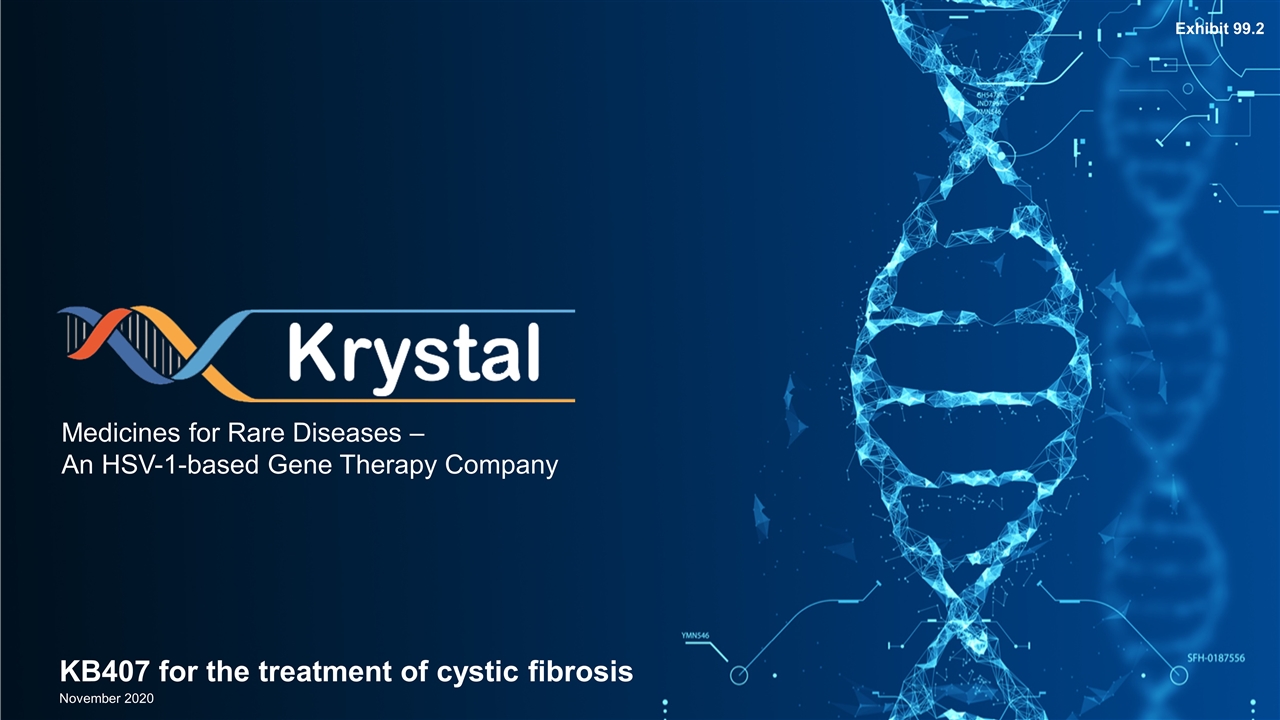
KB407 for the treatment of cystic fibrosis November 2020 Exhibit 99.2
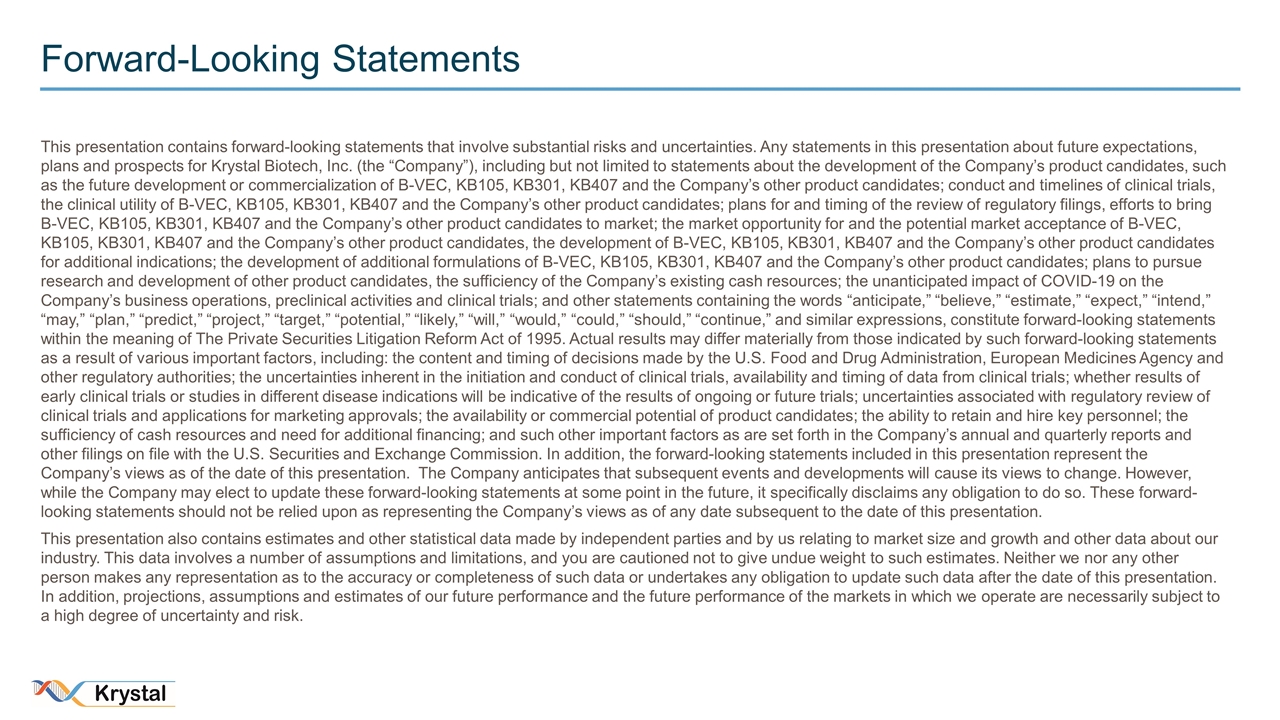
Forward-Looking Statements This presentation contains forward-looking statements that involve substantial risks and uncertainties. Any statements in this presentation about future expectations, plans and prospects for Krystal Biotech, Inc. (the “Company”), including but not limited to statements about the development of the Company’s product candidates, such as the future development or commercialization of B-VEC, KB105, KB301, KB407 and the Company’s other product candidates; conduct and timelines of clinical trials, the clinical utility of B-VEC, KB105, KB301, KB407 and the Company’s other product candidates; plans for and timing of the review of regulatory filings, efforts to bring B-VEC, KB105, KB301, KB407 and the Company’s other product candidates to market; the market opportunity for and the potential market acceptance of B-VEC, KB105, KB301, KB407 and the Company’s other product candidates, the development of B-VEC, KB105, KB301, KB407 and the Company’s other product candidates for additional indications; the development of additional formulations of B-VEC, KB105, KB301, KB407 and the Company’s other product candidates; plans to pursue research and development of other product candidates, the sufficiency of the Company’s existing cash resources; the unanticipated impact of COVID-19 on the Company’s business operations, preclinical activities and clinical trials; and other statements containing the words “anticipate,” “believe,” “estimate,” “expect,” “intend,” “may,” “plan,” “predict,” “project,” “target,” “potential,” “likely,” “will,” “would,” “could,” “should,” “continue,” and similar expressions, constitute forward-looking statements within the meaning of The Private Securities Litigation Reform Act of 1995. Actual results may differ materially from those indicated by such forward-looking statements as a result of various important factors, including: the content and timing of decisions made by the U.S. Food and Drug Administration, European Medicines Agency and other regulatory authorities; the uncertainties inherent in the initiation and conduct of clinical trials, availability and timing of data from clinical trials; whether results of early clinical trials or studies in different disease indications will be indicative of the results of ongoing or future trials; uncertainties associated with regulatory review of clinical trials and applications for marketing approvals; the availability or commercial potential of product candidates; the ability to retain and hire key personnel; the sufficiency of cash resources and need for additional financing; and such other important factors as are set forth in the Company’s annual and quarterly reports and other filings on file with the U.S. Securities and Exchange Commission. In addition, the forward-looking statements included in this presentation represent the Company’s views as of the date of this presentation. The Company anticipates that subsequent events and developments will cause its views to change. However, while the Company may elect to update these forward-looking statements at some point in the future, it specifically disclaims any obligation to do so. These forward-looking statements should not be relied upon as representing the Company’s views as of any date subsequent to the date of this presentation. This presentation also contains estimates and other statistical data made by independent parties and by us relating to market size and growth and other data about our industry. This data involves a number of assumptions and limitations, and you are cautioned not to give undue weight to such estimates. Neither we nor any other person makes any representation as to the accuracy or completeness of such data or undertakes any obligation to update such data after the date of this presentation. In addition, projections, assumptions and estimates of our future performance and the future performance of the markets in which we operate are necessarily subject to a high degree of uncertainty and risk.
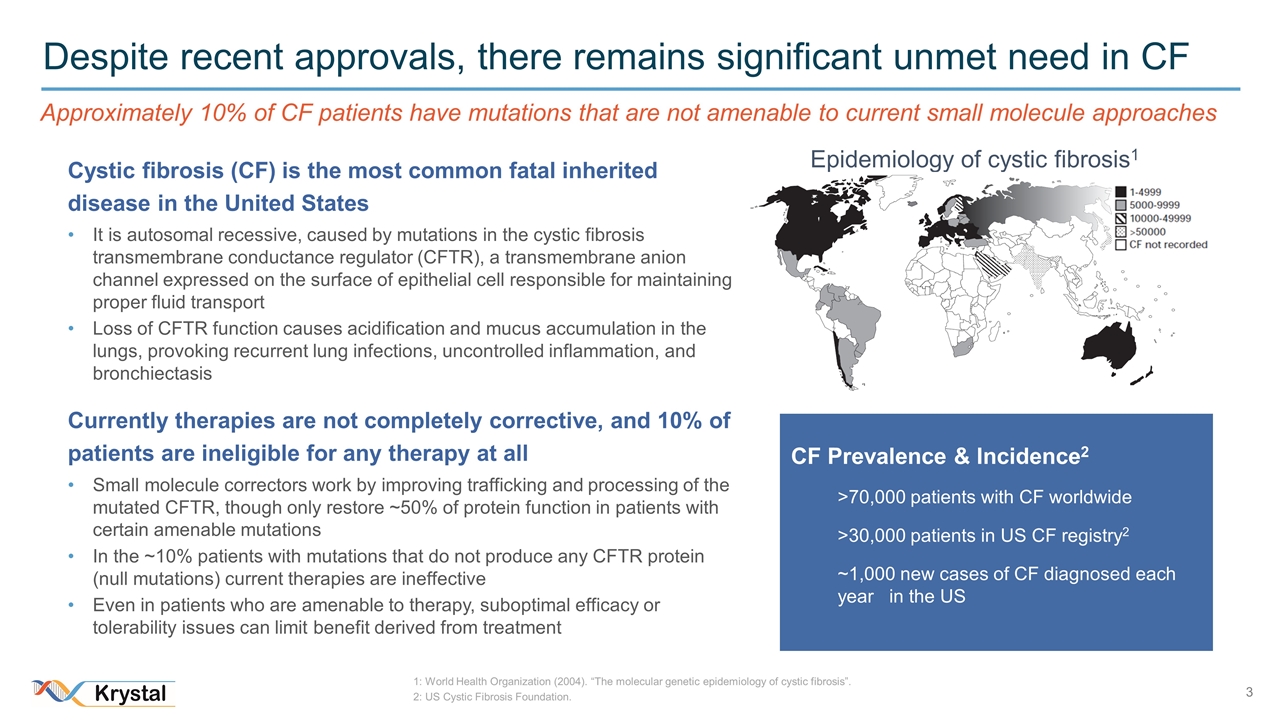
Despite recent approvals, there remains significant unmet need in CF Epidemiology of cystic fibrosis1 CF Prevalence & Incidence2 >70,000 patients with CF worldwide >30,000 patients in US CF registry2 ~1,000 new cases of CF diagnosed each year in the US 1: World Health Organization (2004). “The molecular genetic epidemiology of cystic fibrosis”. 2: US Cystic Fibrosis Foundation. Cystic fibrosis (CF) is the most common fatal inherited disease in the United States It is autosomal recessive, caused by mutations in the cystic fibrosis transmembrane conductance regulator (CFTR), a transmembrane anion channel expressed on the surface of epithelial cell responsible for maintaining proper fluid transport Loss of CFTR function causes acidification and mucus accumulation in the lungs, provoking recurrent lung infections, uncontrolled inflammation, and bronchiectasis Currently therapies are not completely corrective, and 10% of patients are ineligible for any therapy at all Small molecule correctors work by improving trafficking and processing of the mutated CFTR, though only restore ~50% of protein function in patients with certain amenable mutations In the ~10% patients with mutations that do not produce any CFTR protein (null mutations) current therapies are ineffective Even in patients who are amenable to therapy, suboptimal efficacy or tolerability issues can limit benefit derived from treatment Approximately 10% of CF patients have mutations that are not amenable to current small molecule approaches
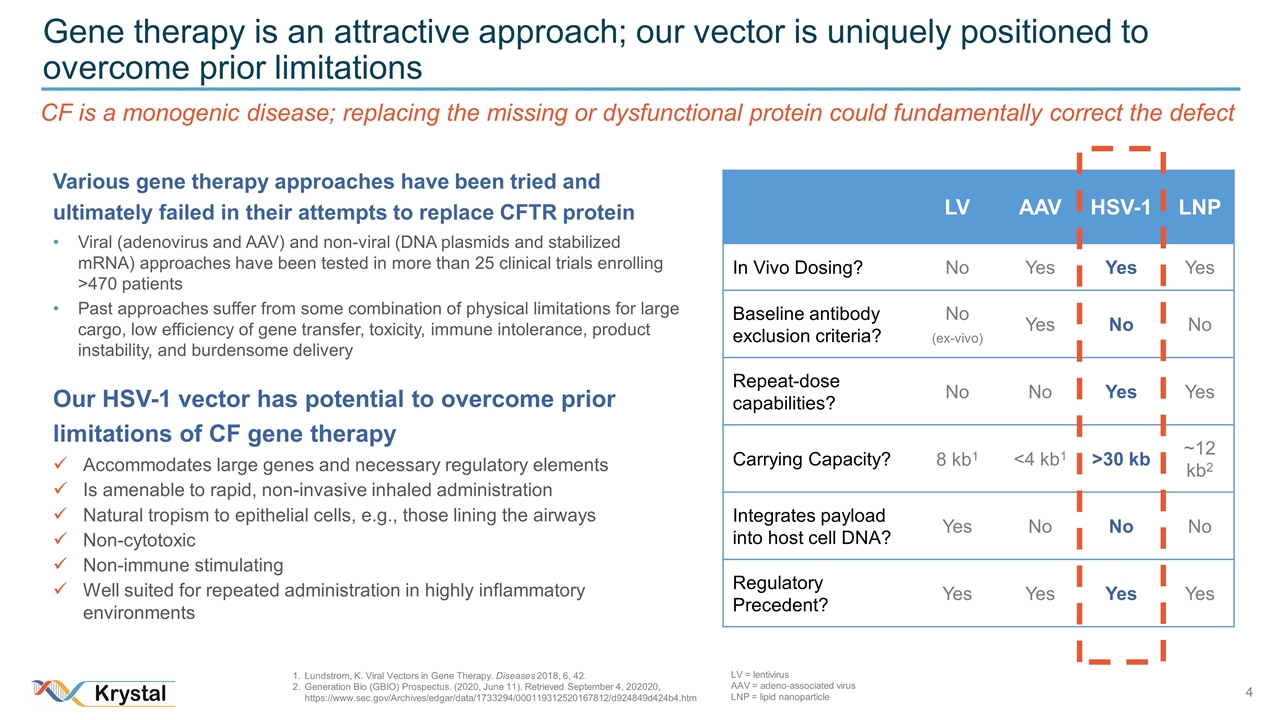
Gene therapy is an attractive approach; our vector is uniquely positioned to overcome prior limitations CF is a monogenic disease; replacing the missing or dysfunctional protein could fundamentally correct the defect Various gene therapy approaches have been tried and ultimately failed in their attempts to replace CFTR protein Viral (adenovirus and AAV) and non-viral (DNA plasmids and stabilized mRNA) approaches have been tested in more than 25 clinical trials enrolling >470 patients Past approaches suffer from some combination of physical limitations for large cargo, low efficiency of gene transfer, toxicity, immune intolerance, product instability, and burdensome delivery Our HSV-1 vector has potential to overcome prior limitations of CF gene therapy Accommodates large genes and necessary regulatory elements Is amenable to rapid, non-invasive inhaled administration Natural tropism to epithelial cells, e.g., those lining the airways Non-cytotoxic Non-immune stimulating Well suited for repeated administration in highly inflammatory environments LV AAV HSV-1 LNP In Vivo Dosing? No Yes Yes Yes Baseline antibody exclusion criteria? No (ex-vivo) Yes No No Repeat-dose capabilities? No No Yes Yes Carrying Capacity? 8 kb1 <4 kb1 >30 kb ~12 kb2 Integrates payload into host cell DNA? Yes No No No Regulatory Precedent? Yes Yes Yes Yes Lundstrom, K. Viral Vectors in Gene Therapy. Diseases 2018, 6, 42. Generation Bio (GBIO) Prospectus. (2020, June 11). Retrieved September 4, 202020, https://www.sec.gov/Archives/edgar/data/1733294/000119312520167812/d924849d424b4.htm LV = lentivirus AAV = adeno-associated virus LNP = lipid nanoparticle
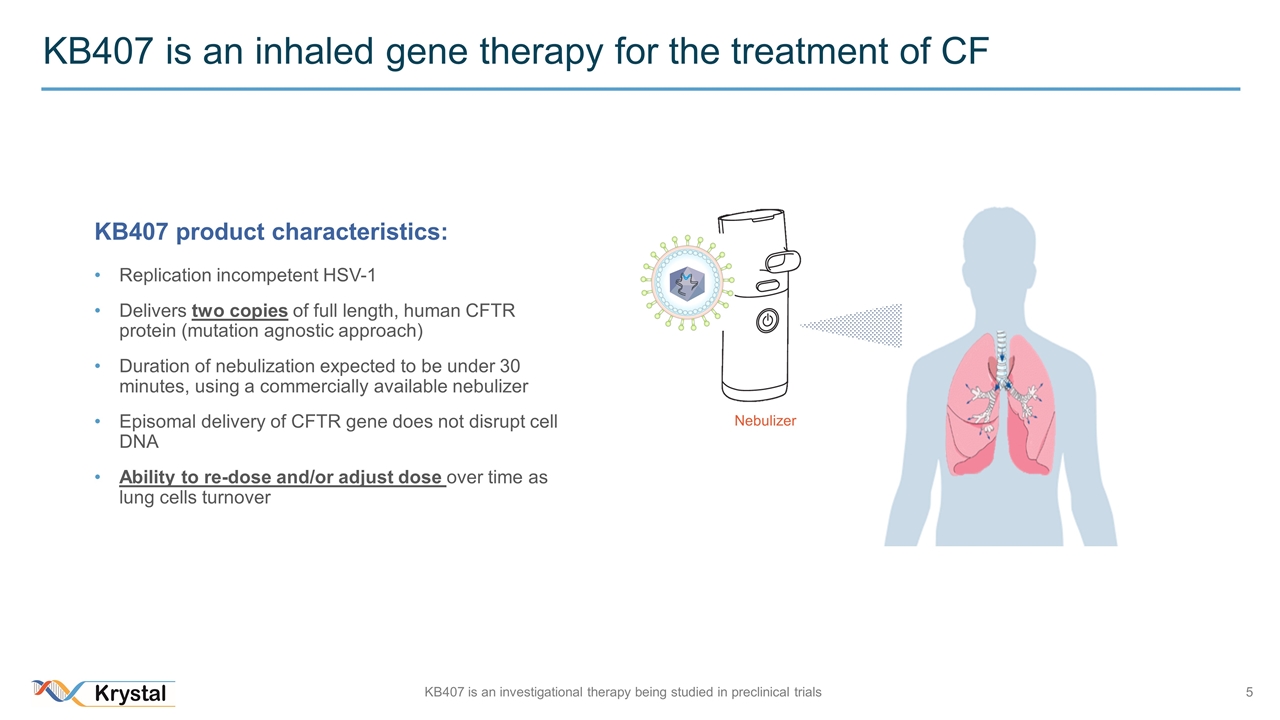
KB407 is an inhaled gene therapy for the treatment of CF Nebulizer KB407 product characteristics: Replication incompetent HSV-1 Delivers two copies of full length, human CFTR protein (mutation agnostic approach) Duration of nebulization expected to be under 30 minutes, using a commercially available nebulizer Episomal delivery of CFTR gene does not disrupt cell DNA Ability to re-dose and/or adjust dose over time as lung cells turnover KB407 is an investigational therapy being studied in preclinical trials
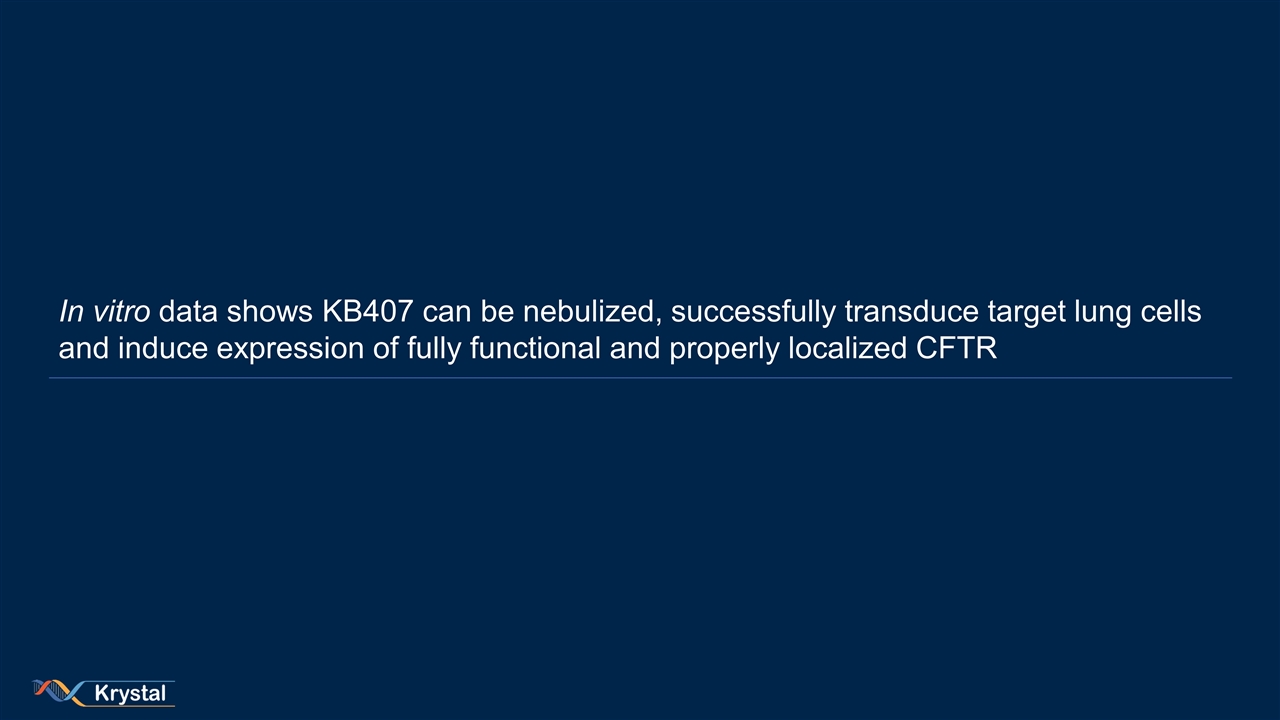
In vitro data shows KB407 can be nebulized, successfully transduce target lung cells and induce expression of fully functional and properly localized CFTR
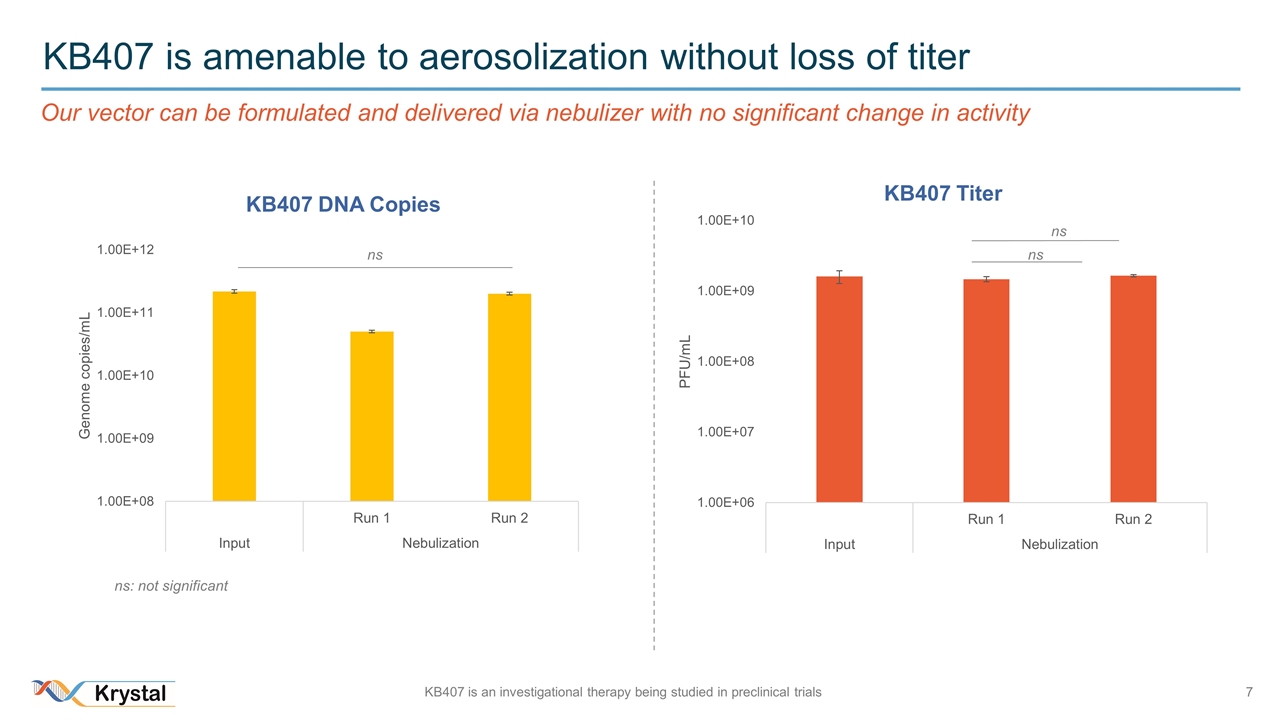
KB407 is amenable to aerosolization without loss of titer ns ns ns: not significant ns Our vector can be formulated and delivered via nebulizer with no significant change in activity KB407 is an investigational therapy being studied in preclinical trials
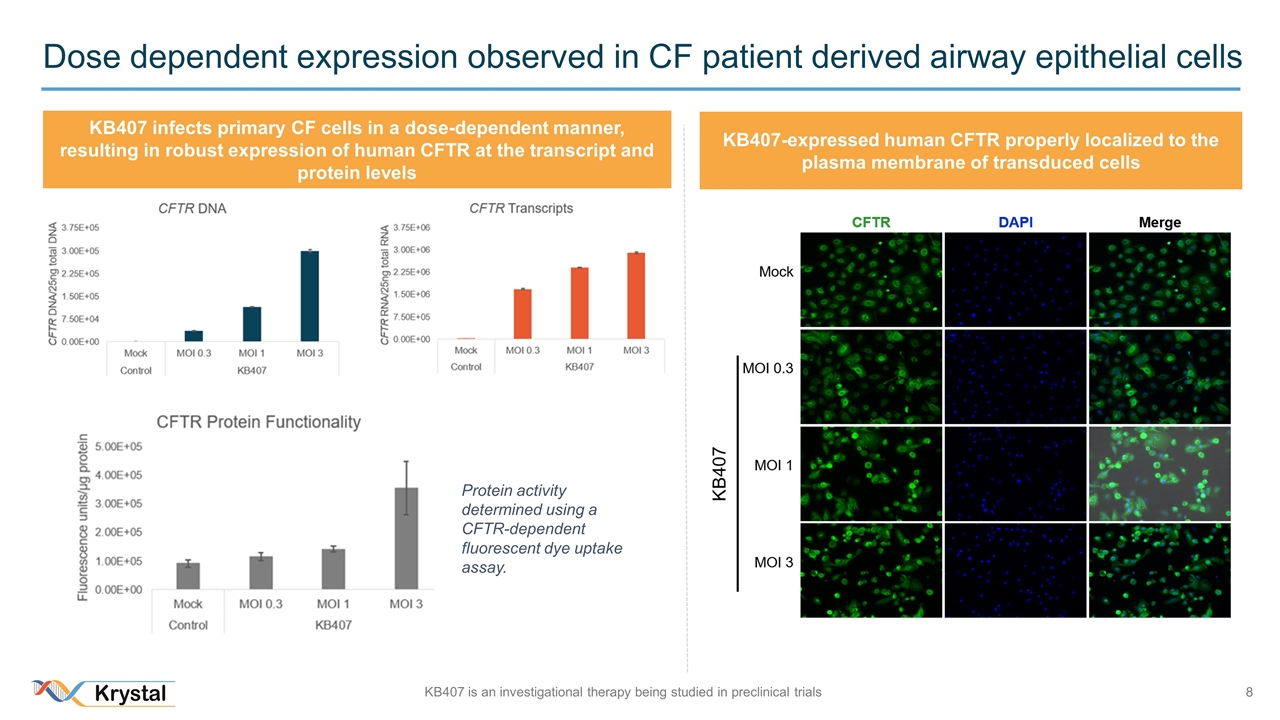
Dose dependent expression observed in CF patient derived airway epithelial cells Protein activity determined using a CFTR-dependent fluorescent dye uptake assay. KB407 infects primary CF cells in a dose-dependent manner, resulting in robust expression of human CFTR at the transcript and protein levels KB407-expressed human CFTR properly localized to the plasma membrane of transduced cells KB407 is an investigational therapy being studied in preclinical trials
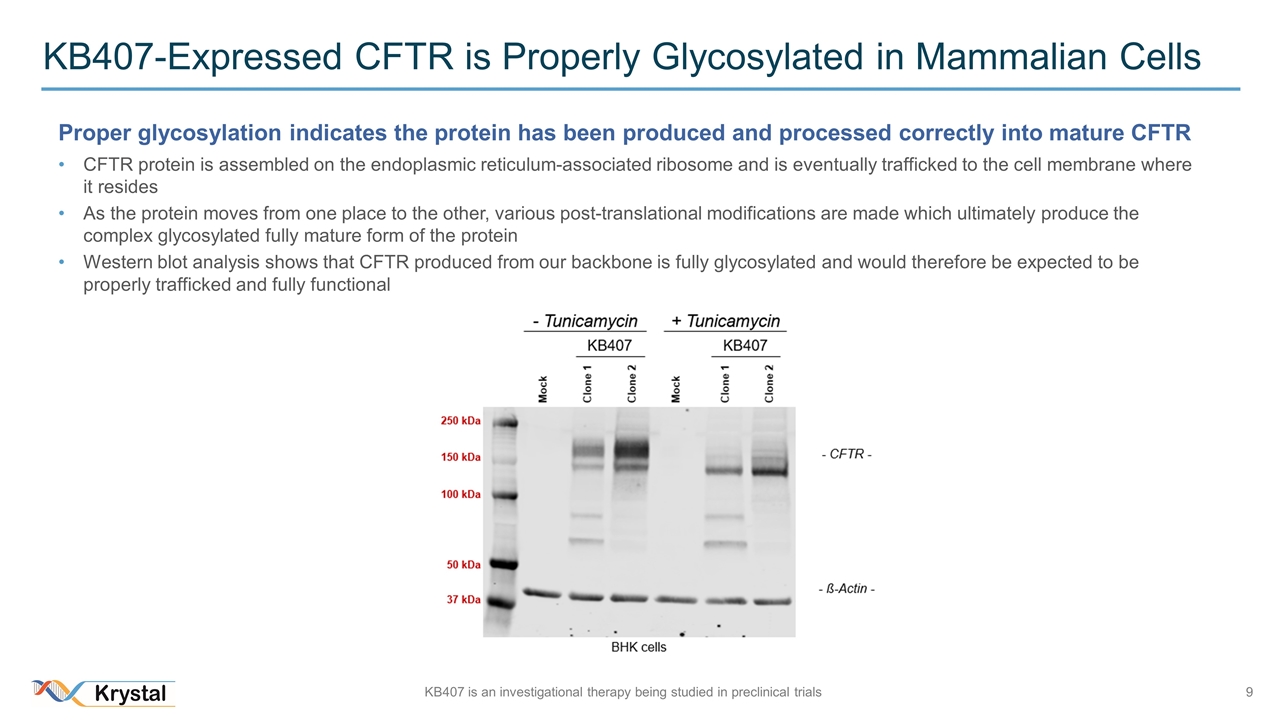
KB407-Expressed CFTR is Properly Glycosylated in Mammalian Cells Proper glycosylation indicates the protein has been produced and processed correctly into mature CFTR CFTR protein is assembled on the endoplasmic reticulum-associated ribosome and is eventually trafficked to the cell membrane where it resides As the protein moves from one place to the other, various post-translational modifications are made which ultimately produce the complex glycosylated fully mature form of the protein Western blot analysis shows that CFTR produced from our backbone is fully glycosylated and would therefore be expected to be properly trafficked and fully functional KB407 is an investigational therapy being studied in preclinical trials
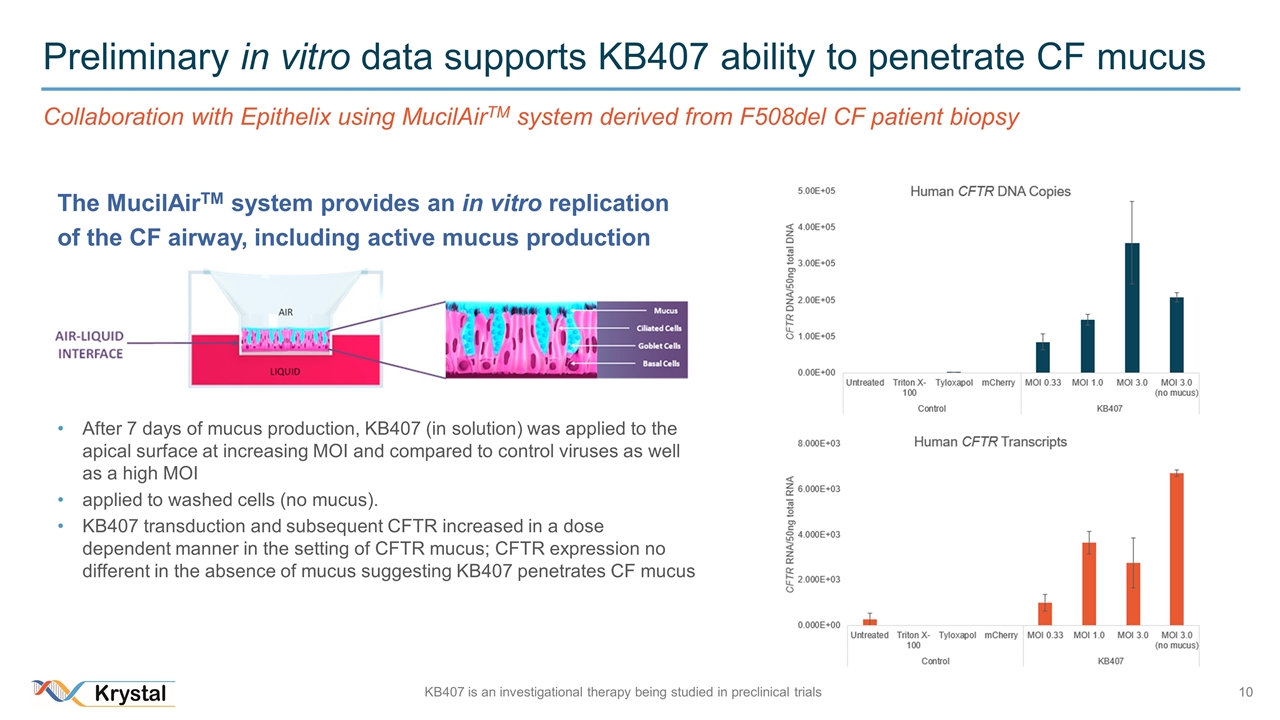
Preliminary in vitro data supports KB407 ability to penetrate CF mucus Collaboration with Epithelix using MucilAirTM system derived from F508del CF patient biopsy The MucilAirTM system provides an in vitro replication of the CF airway, including active mucus production After 7 days of mucus production, KB407 (in solution) was applied to the apical surface at increasing MOI and compared to control viruses as well as a high MOI applied to washed cells (no mucus). KB407 transduction and subsequent CFTR increased in a dose dependent manner in the setting of CFTR mucus; CFTR expression no different in the absence of mucus suggesting KB407 penetrates CF mucus KB407 is an investigational therapy being studied in preclinical trials
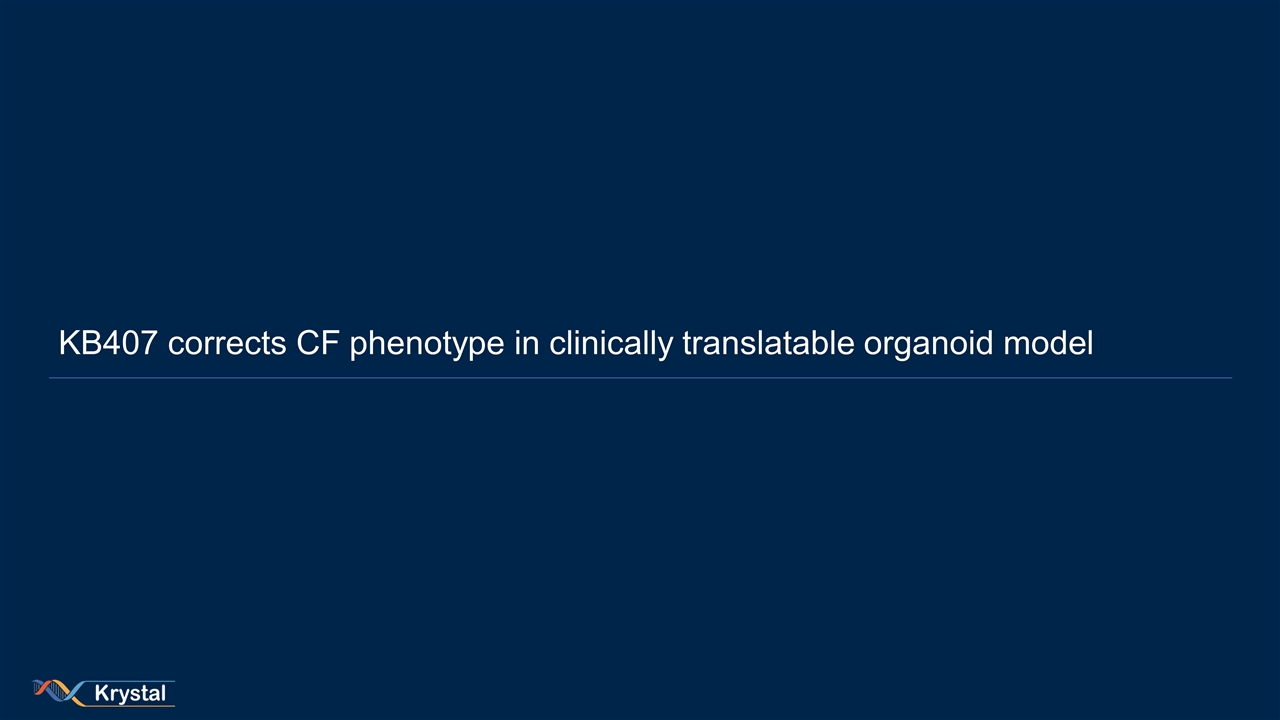
KB407 corrects CF phenotype in clinically translatable organoid model
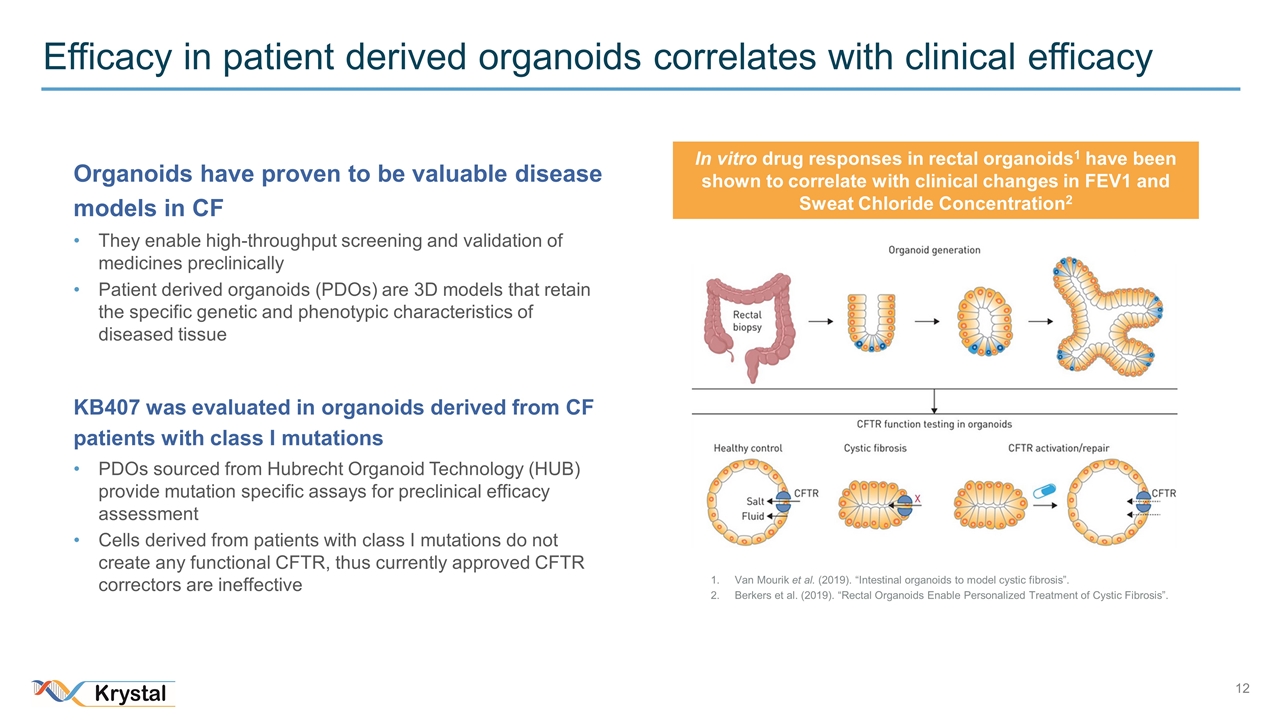
Efficacy in patient derived organoids correlates with clinical efficacy Van Mourik et al. (2019). “Intestinal organoids to model cystic fibrosis”. Berkers et al. (2019). “Rectal Organoids Enable Personalized Treatment of Cystic Fibrosis”. Organoids have proven to be valuable disease models in CF They enable high-throughput screening and validation of medicines preclinically Patient derived organoids (PDOs) are 3D models that retain the specific genetic and phenotypic characteristics of diseased tissue KB407 was evaluated in organoids derived from CF patients with class I mutations PDOs sourced from Hubrecht Organoid Technology (HUB) provide mutation specific assays for preclinical efficacy assessment Cells derived from patients with class I mutations do not create any functional CFTR, thus currently approved CFTR correctors are ineffective In vitro drug responses in rectal organoids1 have been shown to correlate with clinical changes in FEV1 and Sweat Chloride Concentration2
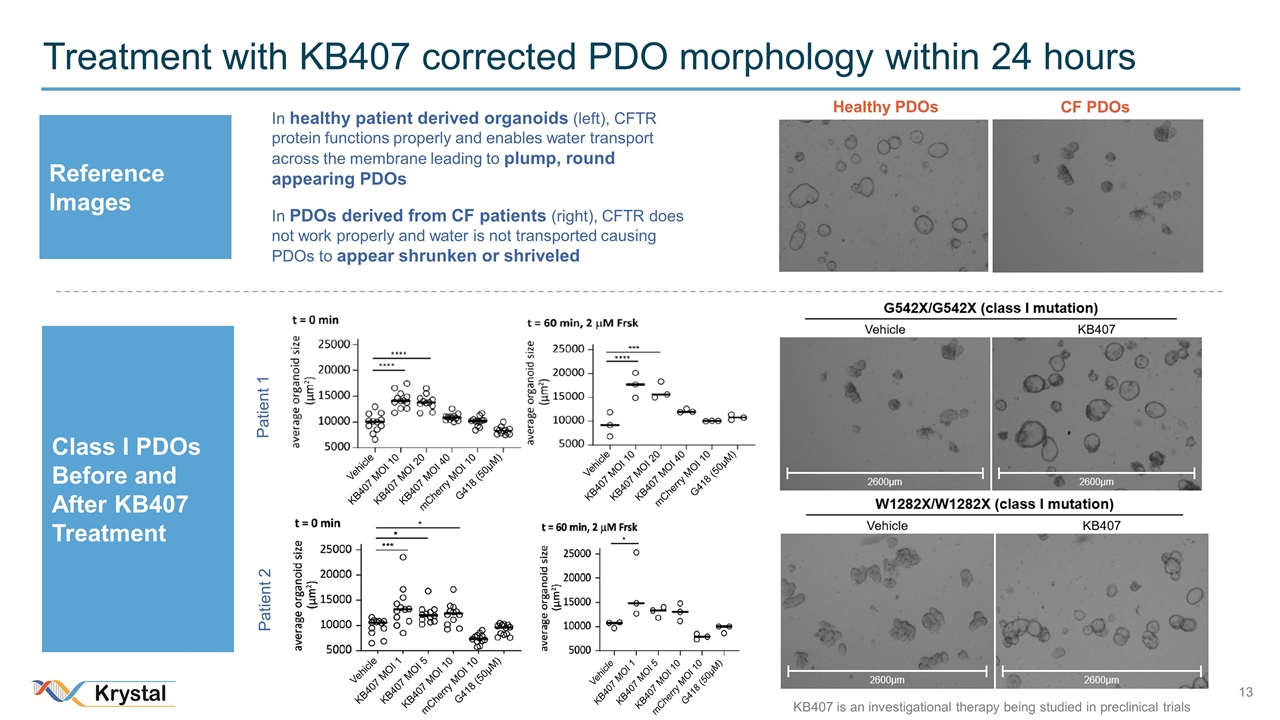
Treatment with KB407 corrected PDO morphology within 24 hours CF PDOs Healthy PDOs In healthy patient derived organoids (left), CFTR protein functions properly and enables water transport across the membrane leading to plump, round appearing PDOs In PDOs derived from CF patients (right), CFTR does not work properly and water is not transported causing PDOs to appear shrunken or shriveled Reference Images Class I PDOs Before and After KB407 Treatment Patient 1 Patient 2 KB407 is an investigational therapy being studied in preclinical trials
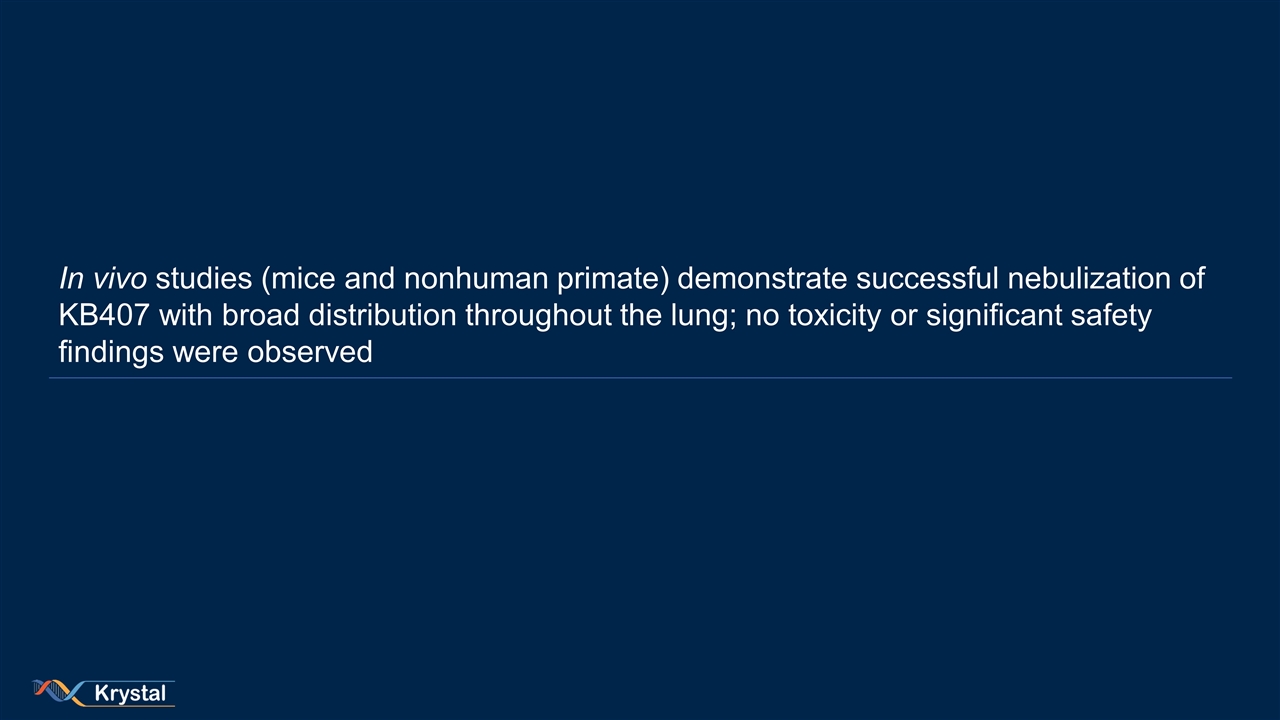
In vivo studies (mice and nonhuman primate) demonstrate successful nebulization of KB407 with broad distribution throughout the lung; no toxicity or significant safety findings were observed
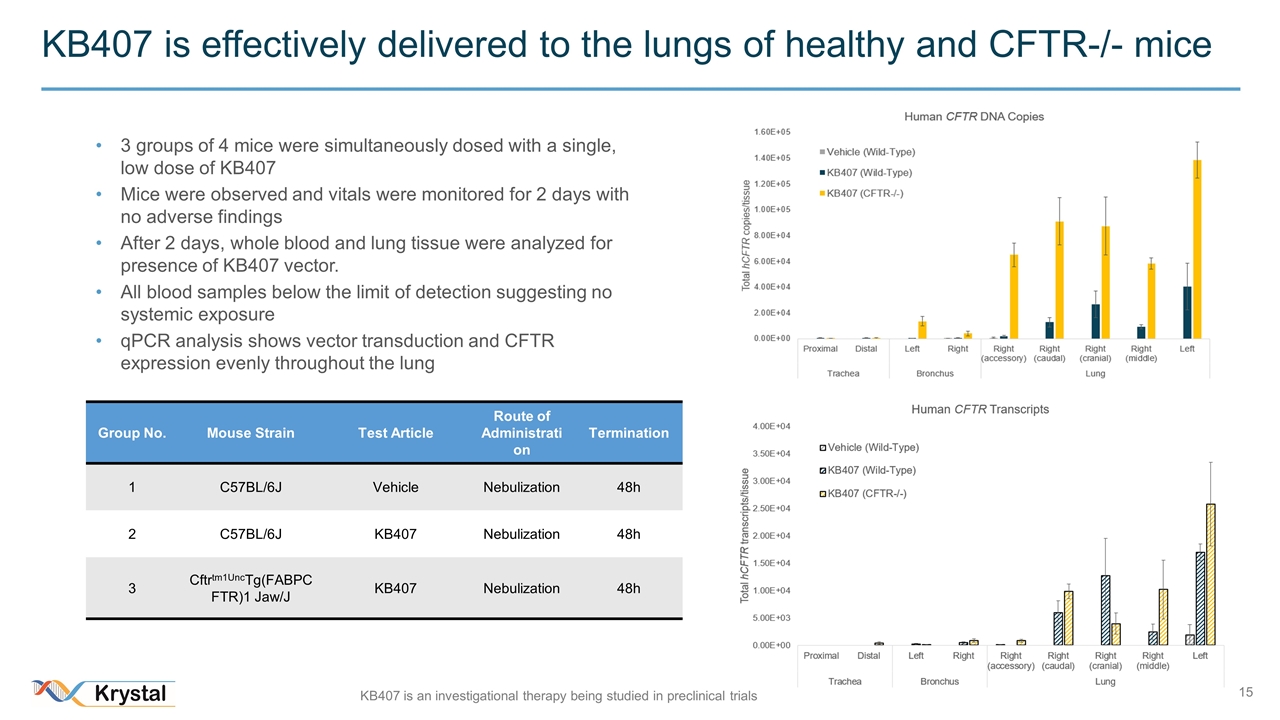
KB407 is effectively delivered to the lungs of healthy and CFTR-/- mice Group No. Mouse Strain Test Article Route of Administration Termination 1 C57BL/6J Vehicle Nebulization 48h 2 C57BL/6J KB407 Nebulization 48h 3 Cftrtm1UncTg(FABPCFTR)1 Jaw/J KB407 Nebulization 48h 3 groups of 4 mice were simultaneously dosed with a single, low dose of KB407 Mice were observed and vitals were monitored for 2 days with no adverse findings After 2 days, whole blood and lung tissue were analyzed for presence of KB407 vector. All blood samples below the limit of detection suggesting no systemic exposure qPCR analysis shows vector transduction and CFTR expression evenly throughout the lung KB407 is an investigational therapy being studied in preclinical trials
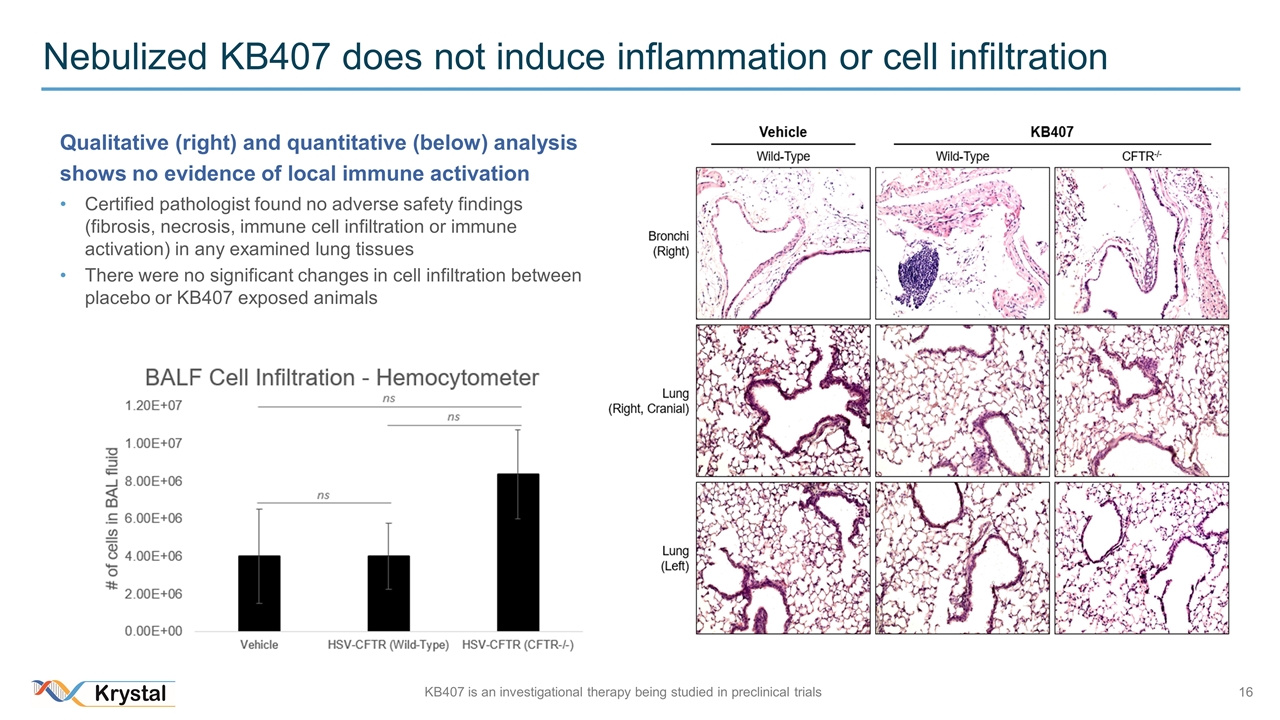
Nebulized KB407 does not induce inflammation or cell infiltration Qualitative (right) and quantitative (below) analysis shows no evidence of local immune activation Certified pathologist found no adverse safety findings (fibrosis, necrosis, immune cell infiltration or immune activation) in any examined lung tissues There were no significant changes in cell infiltration between placebo or KB407 exposed animals KB407 is an investigational therapy being studied in preclinical trials
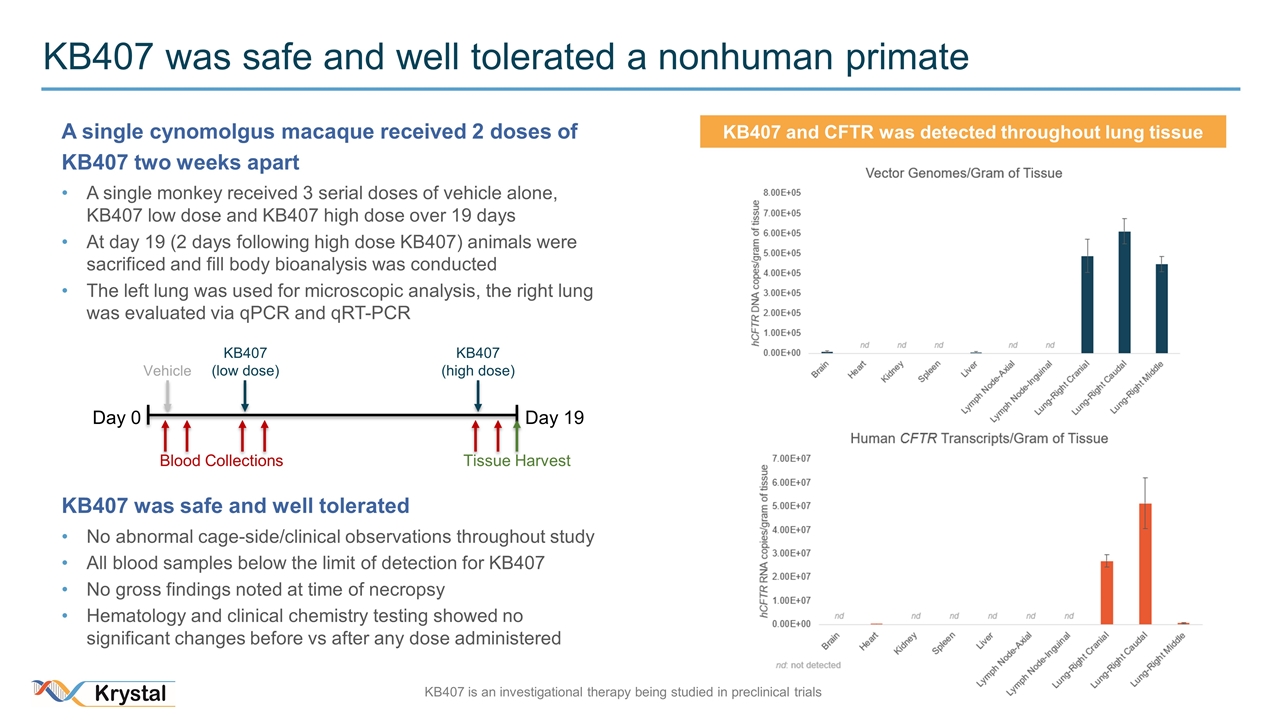
KB407 was safe and well tolerated a nonhuman primate A single cynomolgus macaque received 2 doses of KB407 two weeks apart A single monkey received 3 serial doses of vehicle alone, KB407 low dose and KB407 high dose over 19 days At day 19 (2 days following high dose KB407) animals were sacrificed and fill body bioanalysis was conducted The left lung was used for microscopic analysis, the right lung was evaluated via qPCR and qRT-PCR KB407 was safe and well tolerated No abnormal cage-side/clinical observations throughout study All blood samples below the limit of detection for KB407 No gross findings noted at time of necropsy Hematology and clinical chemistry testing showed no significant changes before vs after any dose administered Day 0 Day 19 Blood Collections Vehicle KB407 (low dose) KB407 (high dose) Tissue Harvest KB407 and CFTR was detected throughout lung tissue KB407 is an investigational therapy being studied in preclinical trials
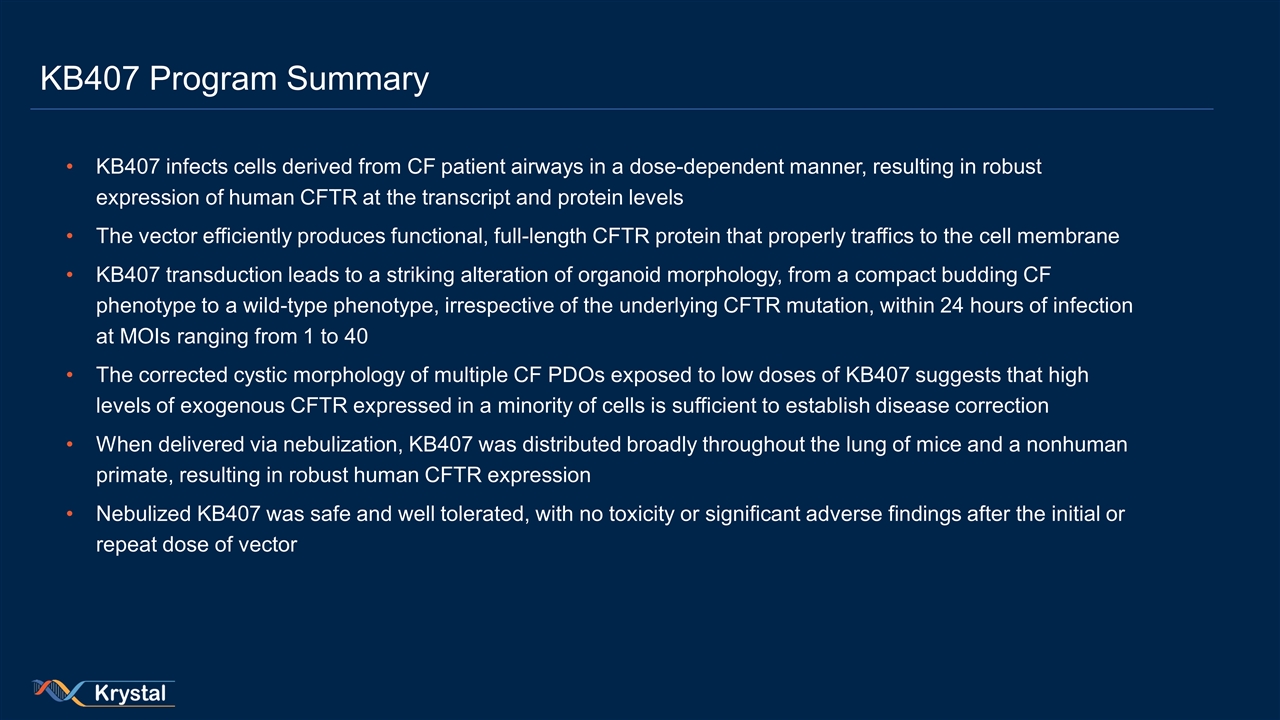
KB407 Program Summary KB407 infects cells derived from CF patient airways in a dose-dependent manner, resulting in robust expression of human CFTR at the transcript and protein levels The vector efficiently produces functional, full-length CFTR protein that properly traffics to the cell membrane KB407 transduction leads to a striking alteration of organoid morphology, from a compact budding CF phenotype to a wild-type phenotype, irrespective of the underlying CFTR mutation, within 24 hours of infection at MOIs ranging from 1 to 40 The corrected cystic morphology of multiple CF PDOs exposed to low doses of KB407 suggests that high levels of exogenous CFTR expressed in a minority of cells is sufficient to establish disease correction When delivered via nebulization, KB407 was distributed broadly throughout the lung of mice and a nonhuman primate, resulting in robust human CFTR expression Nebulized KB407 was safe and well tolerated, with no toxicity or significant adverse findings after the initial or repeat dose of vector
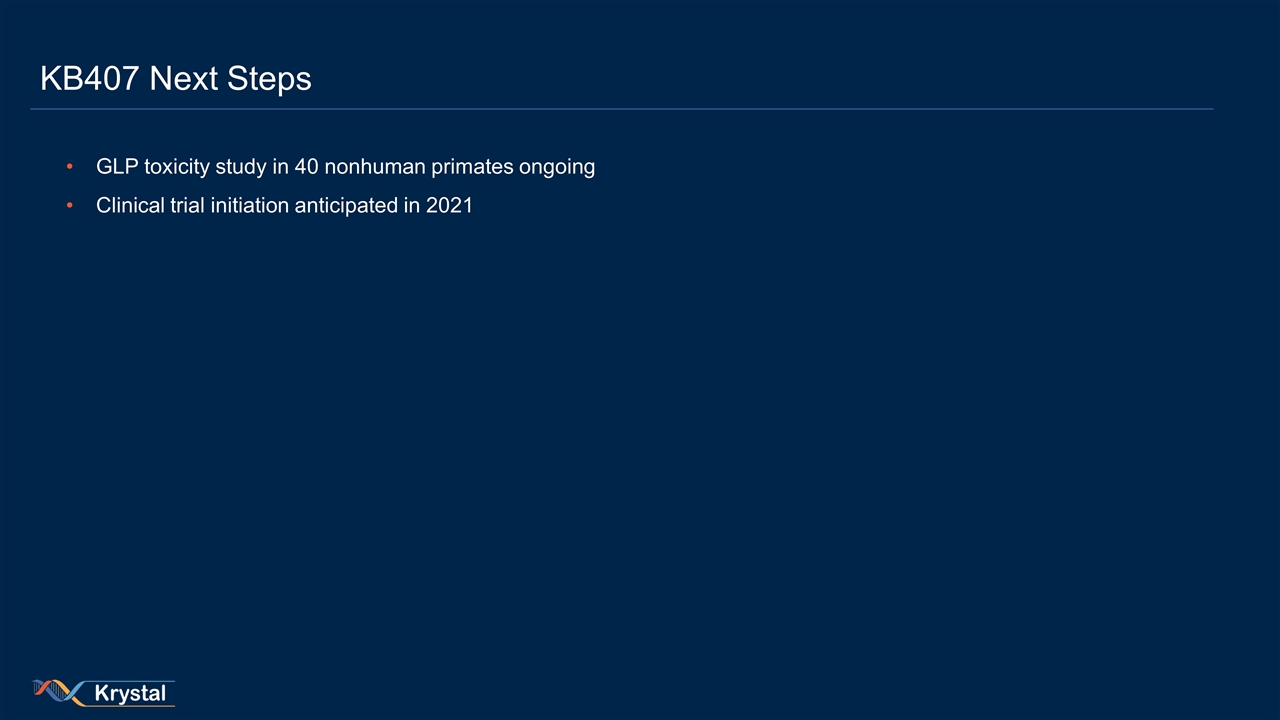
KB407 Next Steps GLP toxicity study in 40 nonhuman primates ongoing Clinical trial initiation anticipated in 2021
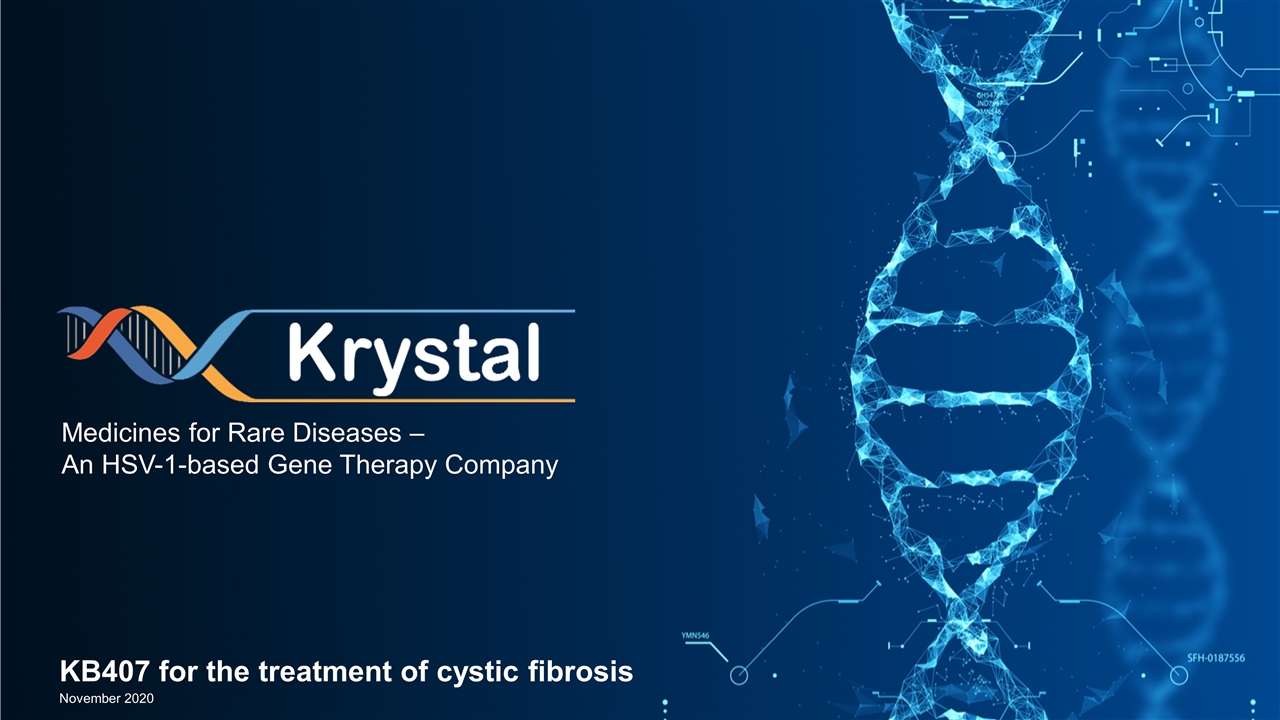
KB407 for the treatment of cystic fibrosis November 2020
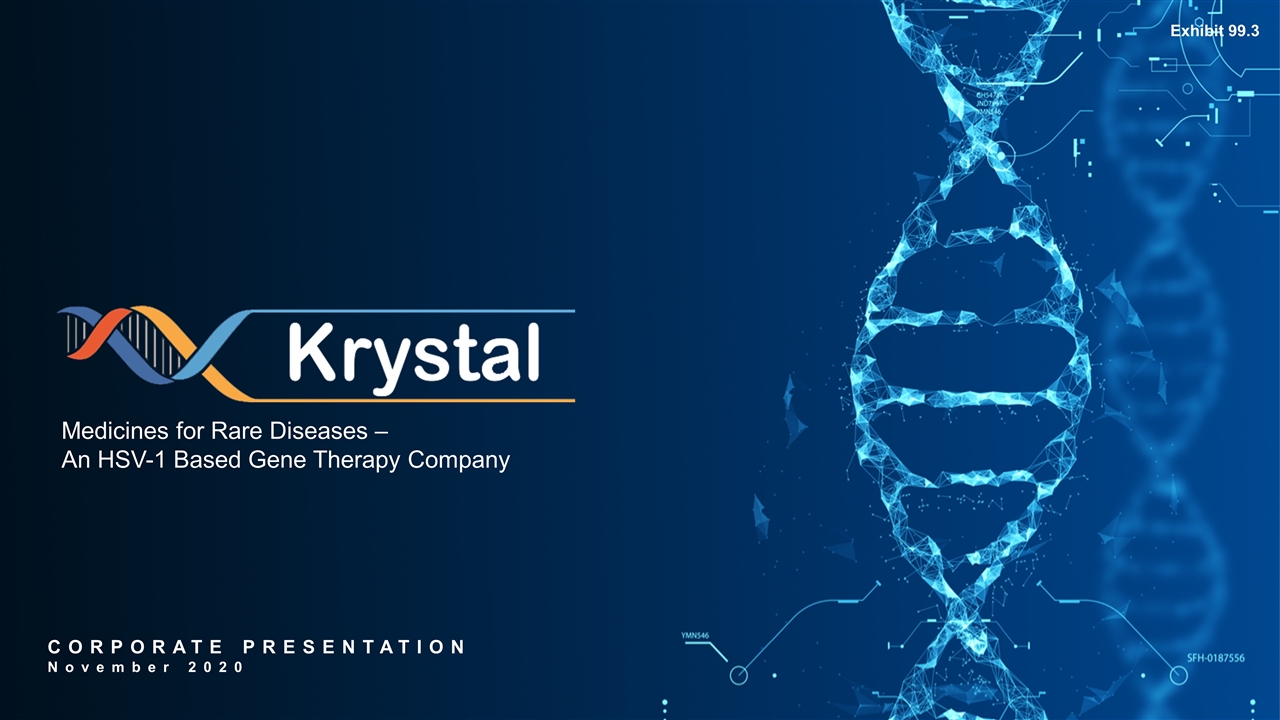
Medicines for Rare Diseases – An HSV-1 Based Gene Therapy Company CORPORATE PRESENTATION November 2020 Exhibit 99.3
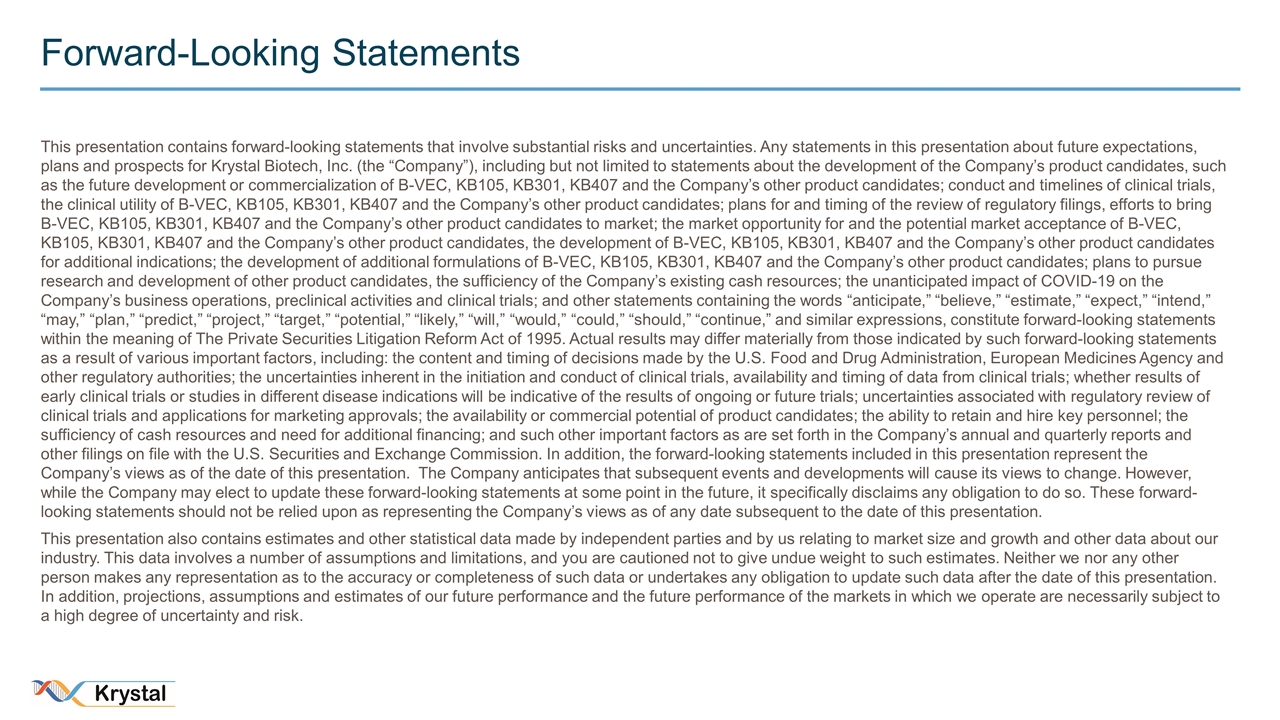
Forward-Looking Statements This presentation contains forward-looking statements that involve substantial risks and uncertainties. Any statements in this presentation about future expectations, plans and prospects for Krystal Biotech, Inc. (the “Company”), including but not limited to statements about the development of the Company’s product candidates, such as the future development or commercialization of B-VEC, KB105, KB301, KB407 and the Company’s other product candidates; conduct and timelines of clinical trials, the clinical utility of B-VEC, KB105, KB301, KB407 and the Company’s other product candidates; plans for and timing of the review of regulatory filings, efforts to bring B-VEC, KB105, KB301, KB407 and the Company’s other product candidates to market; the market opportunity for and the potential market acceptance of B-VEC, KB105, KB301, KB407 and the Company’s other product candidates, the development of B-VEC, KB105, KB301, KB407 and the Company’s other product candidates for additional indications; the development of additional formulations of B-VEC, KB105, KB301, KB407 and the Company’s other product candidates; plans to pursue research and development of other product candidates, the sufficiency of the Company’s existing cash resources; the unanticipated impact of COVID-19 on the Company’s business operations, preclinical activities and clinical trials; and other statements containing the words “anticipate,” “believe,” “estimate,” “expect,” “intend,” “may,” “plan,” “predict,” “project,” “target,” “potential,” “likely,” “will,” “would,” “could,” “should,” “continue,” and similar expressions, constitute forward-looking statements within the meaning of The Private Securities Litigation Reform Act of 1995. Actual results may differ materially from those indicated by such forward-looking statements as a result of various important factors, including: the content and timing of decisions made by the U.S. Food and Drug Administration, European Medicines Agency and other regulatory authorities; the uncertainties inherent in the initiation and conduct of clinical trials, availability and timing of data from clinical trials; whether results of early clinical trials or studies in different disease indications will be indicative of the results of ongoing or future trials; uncertainties associated with regulatory review of clinical trials and applications for marketing approvals; the availability or commercial potential of product candidates; the ability to retain and hire key personnel; the sufficiency of cash resources and need for additional financing; and such other important factors as are set forth in the Company’s annual and quarterly reports and other filings on file with the U.S. Securities and Exchange Commission. In addition, the forward-looking statements included in this presentation represent the Company’s views as of the date of this presentation. The Company anticipates that subsequent events and developments will cause its views to change. However, while the Company may elect to update these forward-looking statements at some point in the future, it specifically disclaims any obligation to do so. These forward-looking statements should not be relied upon as representing the Company’s views as of any date subsequent to the date of this presentation. This presentation also contains estimates and other statistical data made by independent parties and by us relating to market size and growth and other data about our industry. This data involves a number of assumptions and limitations, and you are cautioned not to give undue weight to such estimates. Neither we nor any other person makes any representation as to the accuracy or completeness of such data or undertakes any obligation to update such data after the date of this presentation. In addition, projections, assumptions and estimates of our future performance and the future performance of the markets in which we operate are necessarily subject to a high degree of uncertainty and risk.
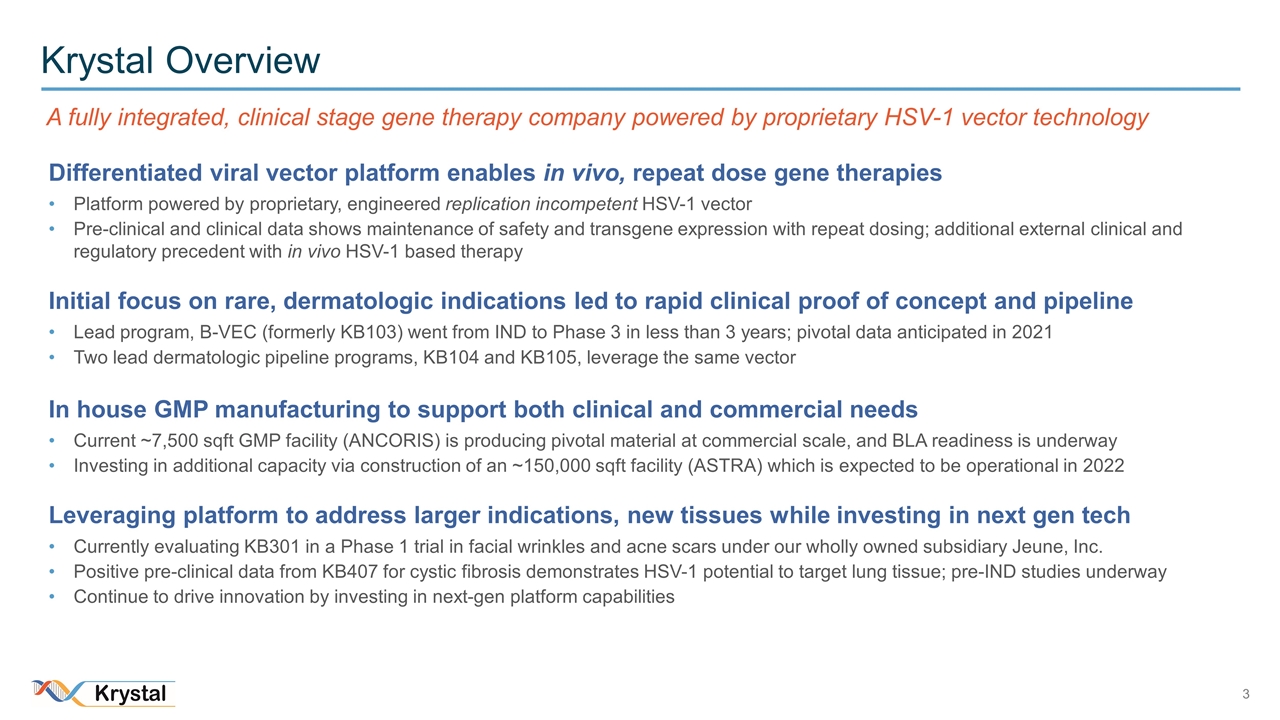
A fully integrated, clinical stage gene therapy company powered by proprietary HSV-1 vector technology Krystal Overview Differentiated viral vector platform enables in vivo, repeat dose gene therapies Platform powered by proprietary, engineered replication incompetent HSV-1 vector Pre-clinical and clinical data shows maintenance of safety and transgene expression with repeat dosing; additional external clinical and regulatory precedent with in vivo HSV-1 based therapy Initial focus on rare, dermatologic indications led to rapid clinical proof of concept and pipeline Lead program, B-VEC (formerly KB103) went from IND to Phase 3 in less than 3 years; pivotal data anticipated in 2021 Two lead dermatologic pipeline programs, KB104 and KB105, leverage the same vector In house GMP manufacturing to support both clinical and commercial needs Current ~7,500 sqft GMP facility (ANCORIS) is producing pivotal material at commercial scale, and BLA readiness is underway Investing in additional capacity via construction of an ~150,000 sqft facility (ASTRA) which is expected to be operational in 2022 Leveraging platform to address larger indications, new tissues while investing in next gen tech Currently evaluating KB301 in a Phase 1 trial in facial wrinkles and acne scars under our wholly owned subsidiary Jeune, Inc. Positive pre-clinical data from KB407 for cystic fibrosis demonstrates HSV-1 potential to target lung tissue; pre-IND studies underway Continue to drive innovation by investing in next-gen platform capabilities
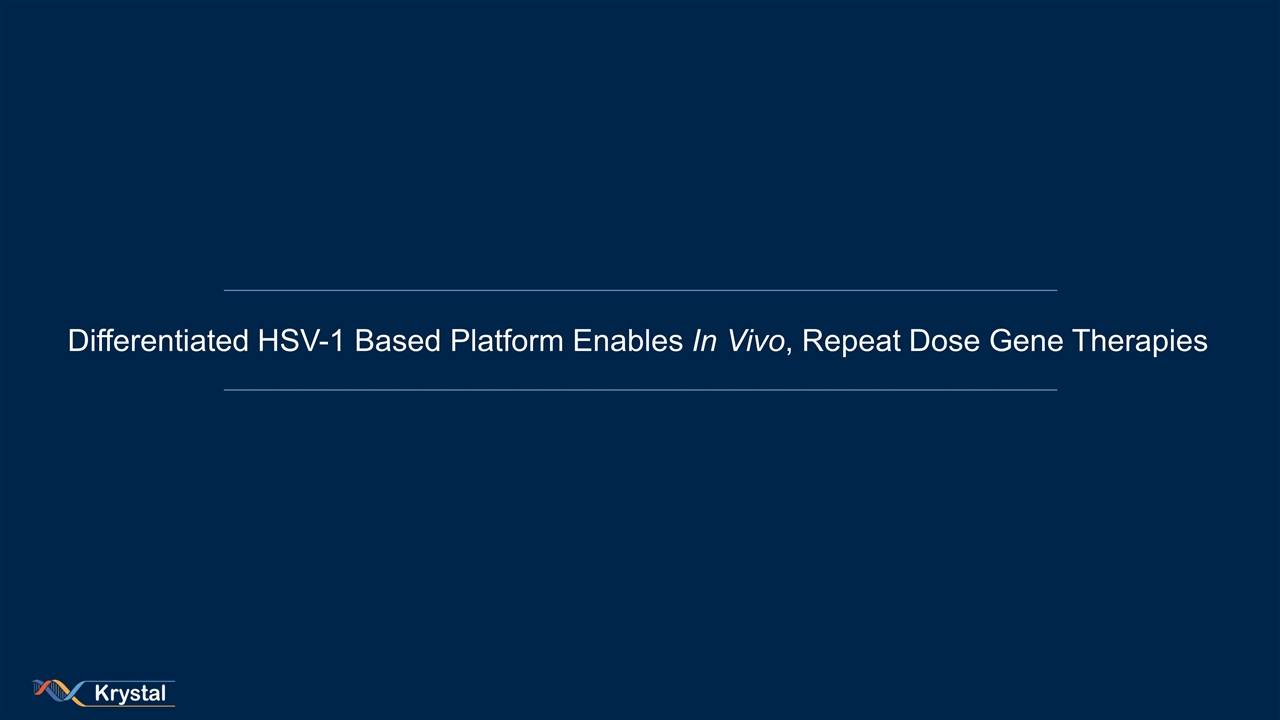
Differentiated HSV-1 Based Platform Enables In Vivo, Repeat Dose Gene Therapies
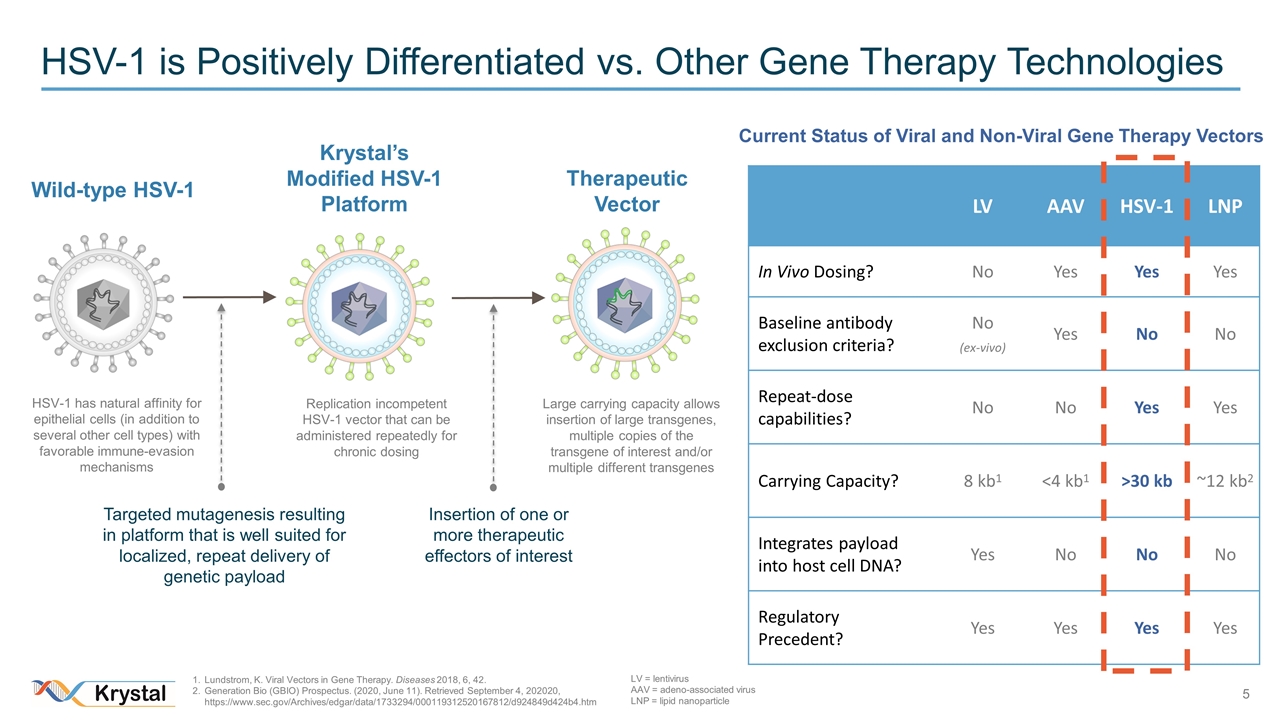
HSV-1 is Positively Differentiated vs. Other Gene Therapy Technologies Targeted mutagenesis resulting in platform that is well suited for localized, repeat delivery of genetic payload Wild-type HSV-1 Krystal’s Modified HSV-1 Platform Insertion of one or more therapeutic effectors of interest Therapeutic Vector HSV-1 has natural affinity for epithelial cells (in addition to several other cell types) with favorable immune-evasion mechanisms Replication incompetent HSV-1 vector that can be administered repeatedly for chronic dosing LV AAV HSV-1 LNP In Vivo Dosing? No Yes Yes Yes Baseline antibody exclusion criteria? No (ex-vivo) Yes No No Repeat-dose capabilities? No No Yes Yes Carrying Capacity? 8 kb1 <4 kb1 >30 kb ~12 kb2 Integrates payload into host cell DNA? Yes No No No Regulatory Precedent? Yes Yes Yes Yes Lundstrom, K. Viral Vectors in Gene Therapy. Diseases 2018, 6, 42. Generation Bio (GBIO) Prospectus. (2020, June 11). Retrieved September 4, 202020, https://www.sec.gov/Archives/edgar/data/1733294/000119312520167812/d924849d424b4.htm Large carrying capacity allows insertion of large transgenes, multiple copies of the transgene of interest and/or multiple different transgenes Current Status of Viral and Non-Viral Gene Therapy Vectors LV = lentivirus AAV = adeno-associated virus LNP = lipid nanoparticle
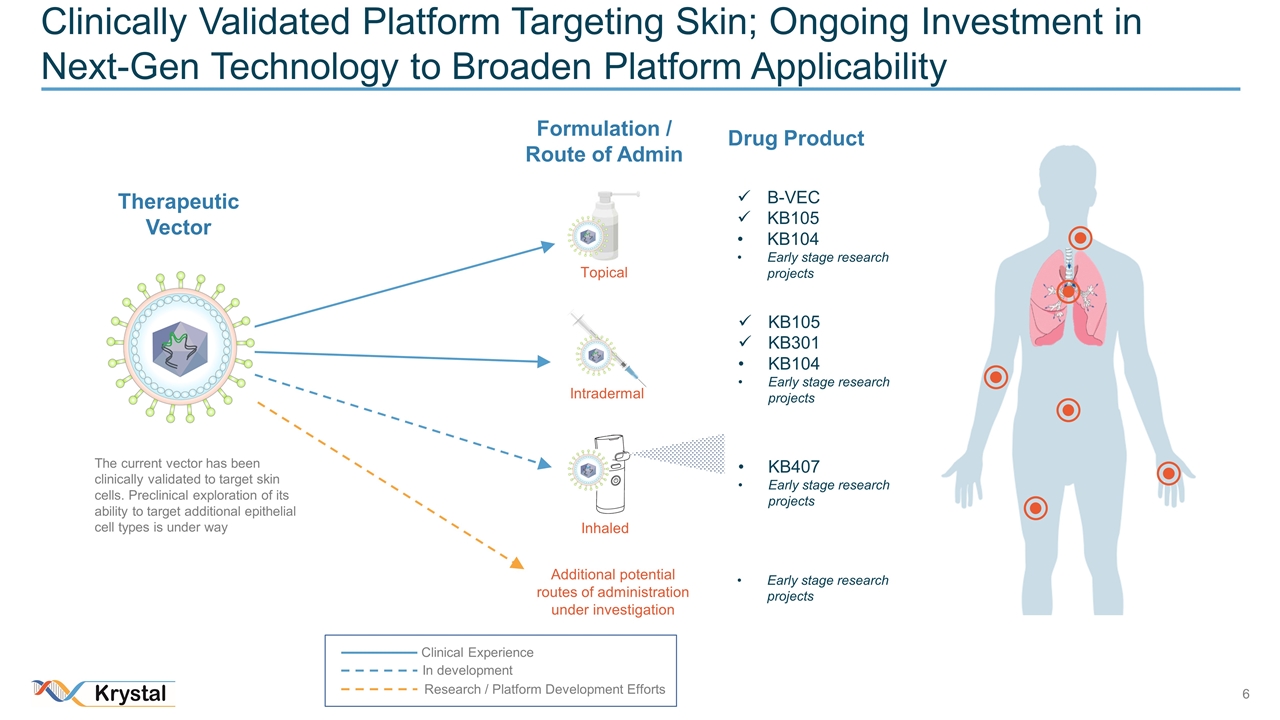
Clinically Validated Platform Targeting Skin; Ongoing Investment in Next-Gen Technology to Broaden Platform Applicability Topical Intradermal Inhaled The current vector has been clinically validated to target skin cells. Preclinical exploration of its ability to target additional epithelial cell types is under way Formulation / Route of Admin Additional potential routes of administration under investigation B-VEC KB105 KB104 Early stage research projects KB105 KB301 KB104 Early stage research projects KB407 Early stage research projects Early stage research projects Drug Product Therapeutic Vector Clinical Experience In development Research / Platform Development Efforts
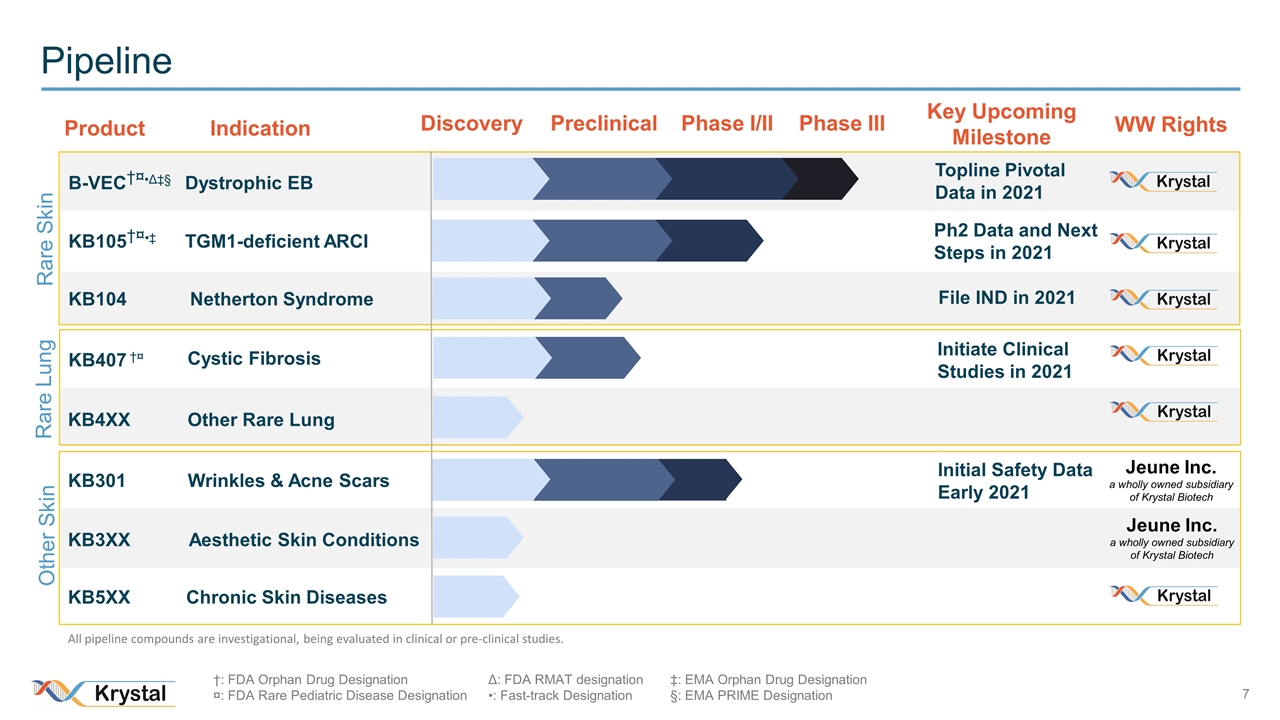
Pipeline Product Indication Discovery Preclinical Phase I/II B-VEC†¤•Δ‡§ Dystrophic EB KB105†¤•‡ TGM1-deficient ARCI Phase III Key Upcoming Milestone †: FDA Orphan Drug Designation ¤: FDA Rare Pediatric Disease Designation KB301 Wrinkles & Acne Scars Netherton Syndrome KB104 Chronic Skin Diseases KB5XX Cystic Fibrosis KB407 †¤ Topline Pivotal Data in 2021 Ph2 Data and Next Steps in 2021 Initial Safety Data Early 2021 File IND in 2021 Initiate Clinical Studies in 2021 Δ: FDA RMAT designation •: Fast-track Designation All pipeline compounds are investigational, being evaluated in clinical or pre-clinical studies. Jeune Inc. a wholly owned subsidiary of Krystal Biotech Other Rare Lung KB4XX Aesthetic Skin Conditions KB3XX Jeune Inc. a wholly owned subsidiary of Krystal Biotech WW Rights Rare Skin Rare Lung Other Skin ‡: EMA Orphan Drug Designation §: EMA PRIME Designation
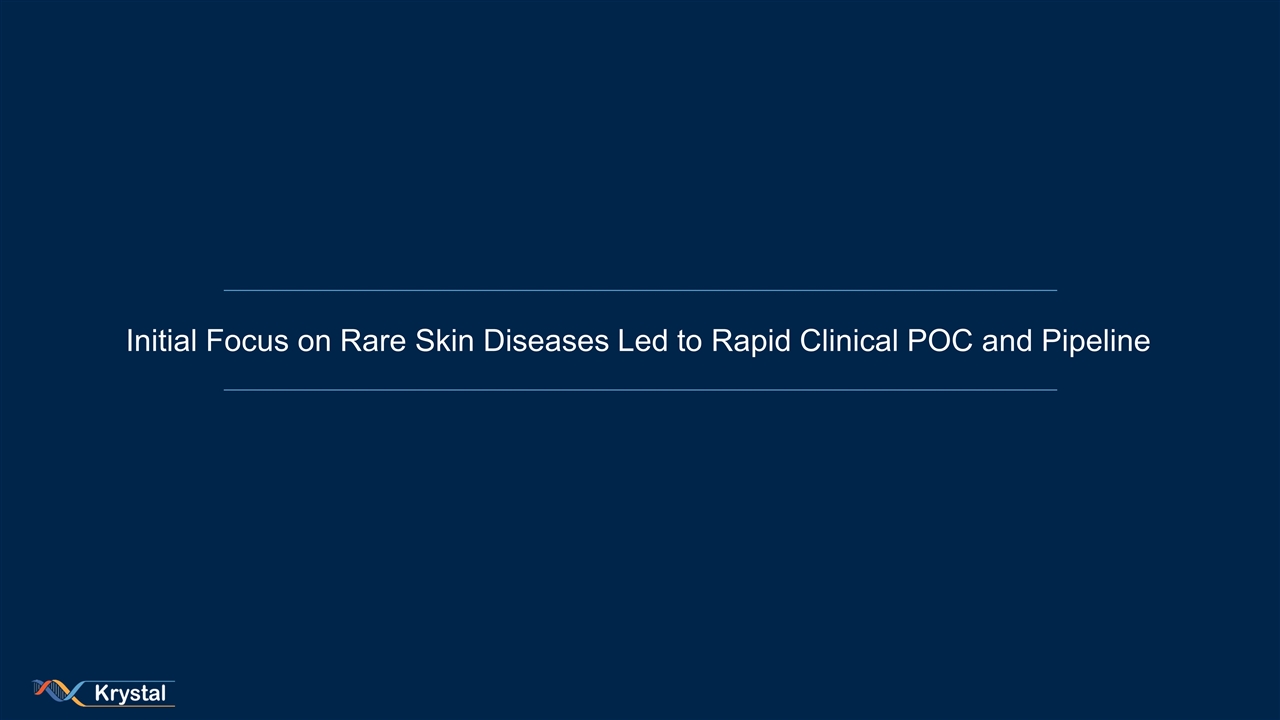
Initial Focus on Rare Skin Diseases Led to Rapid Clinical POC and Pipeline

“Butterfly Children” is used to describe young DEB patients because their skin is as fragile as a butterfly’s wings DEBRA International, http://www.debra-international.org/epidermolysis-bullosa/causes-and-subtypes.html; http://www.debra-international.org/what-is-eb/causes-and-subtypes/deb.html Pfendner EG, Lucky AW. Dystrophic Epidermolysis Bullosa. 2006 Aug 21 [Updated 2015 Feb 26]. In: Adam MP, Ardinger HH, Pagon RA, et al., editors. GeneReviews® [Internet]. Rashidghamat E., Mellerio J.E., Management of chronic wounds in patients with dystrophic epidermolysis bullosa: challenges and solutions, Chronic Wound Care Management and Research Volume 2017:4, 45-54 GENEGRAFT Report Summary. (2015, February 16). Retrieved December 13, 2016, from http://cordis.europa.eu/result/rcn/156078_en.html Dystrophic Epidermolysis Bullosa (DEB) Dystrophic Epidermolysis Bullosa A rare, genetic connective tissue disease that causes skin to tear or blister from minor contact Mutations in the COL7A1 gene lead to absent or dysfunctional COL7 protein, without which the epidermis does not anchor to the dermis The recessive form (RDEB) is the classic, most severe form of the condition. Dominant DEB (DDEB) can be milder with blistering often limited to the hands, feet, knees, and elbows. Epidemiology Prevalence: Up to 125,000 people are affected by DEB worldwide1 We believe that there are, at present, approximately 3,000 diagnosed DEB patients in the United States. Current Standard of Care There are no approved treatments for DEB Existing therapies limited to expensive and time-consuming palliative treatments Palliative treatments cost $200k – $400k annually3,4
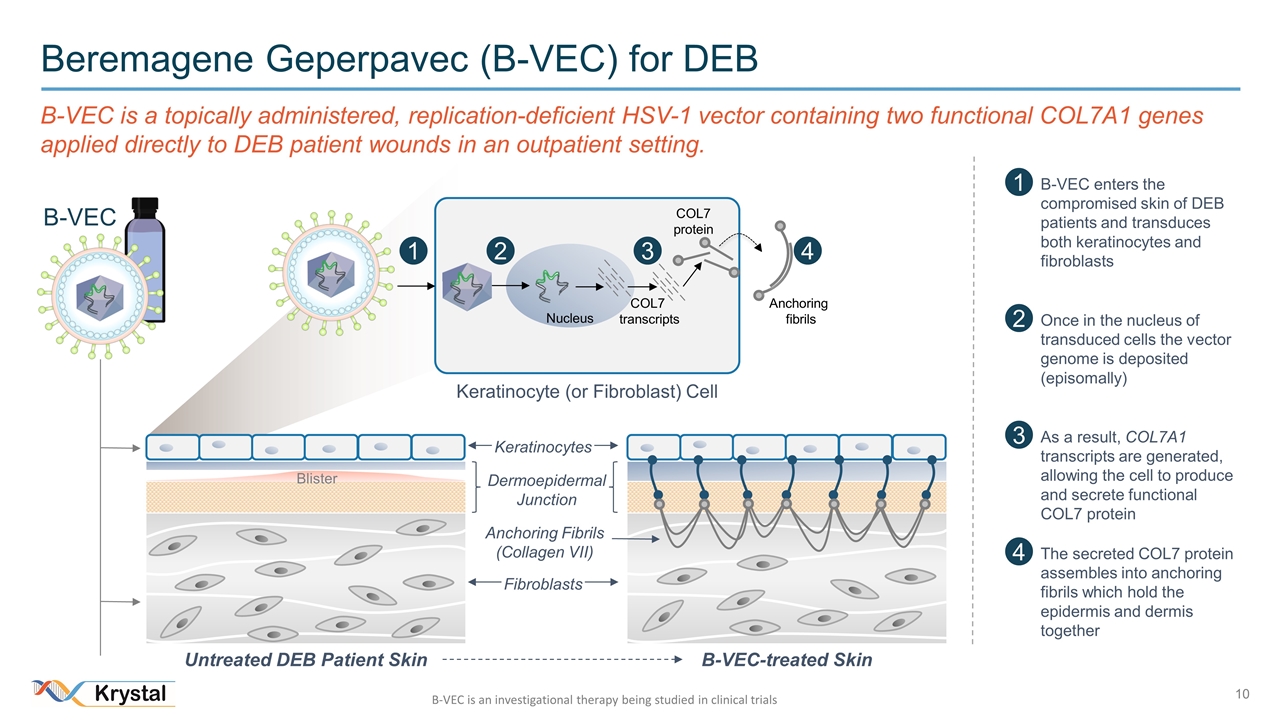
B-VEC is a topically administered, replication-deficient HSV-1 vector containing two functional COL7A1 genes applied directly to DEB patient wounds in an outpatient setting. Beremagene Geperpavec (B-VEC) for DEB Blister Untreated DEB Patient Skin B-VEC-treated Skin 1 Keratinocytes Dermoepidermal Junction Fibroblasts Anchoring Fibrils (Collagen VII) B-VEC 2 3 Nucleus COL7 transcripts COL7 protein Keratinocyte (or Fibroblast) Cell 4 1 B-VEC enters the compromised skin of DEB patients and transduces both keratinocytes and fibroblasts 2 Once in the nucleus of transduced cells the vector genome is deposited (episomally) 3 As a result, COL7A1 transcripts are generated, allowing the cell to produce and secrete functional COL7 protein 4 The secreted COL7 protein assembles into anchoring fibrils which hold the epidermis and dermis together Anchoring fibrils B-VEC is an investigational therapy being studied in clinical trials
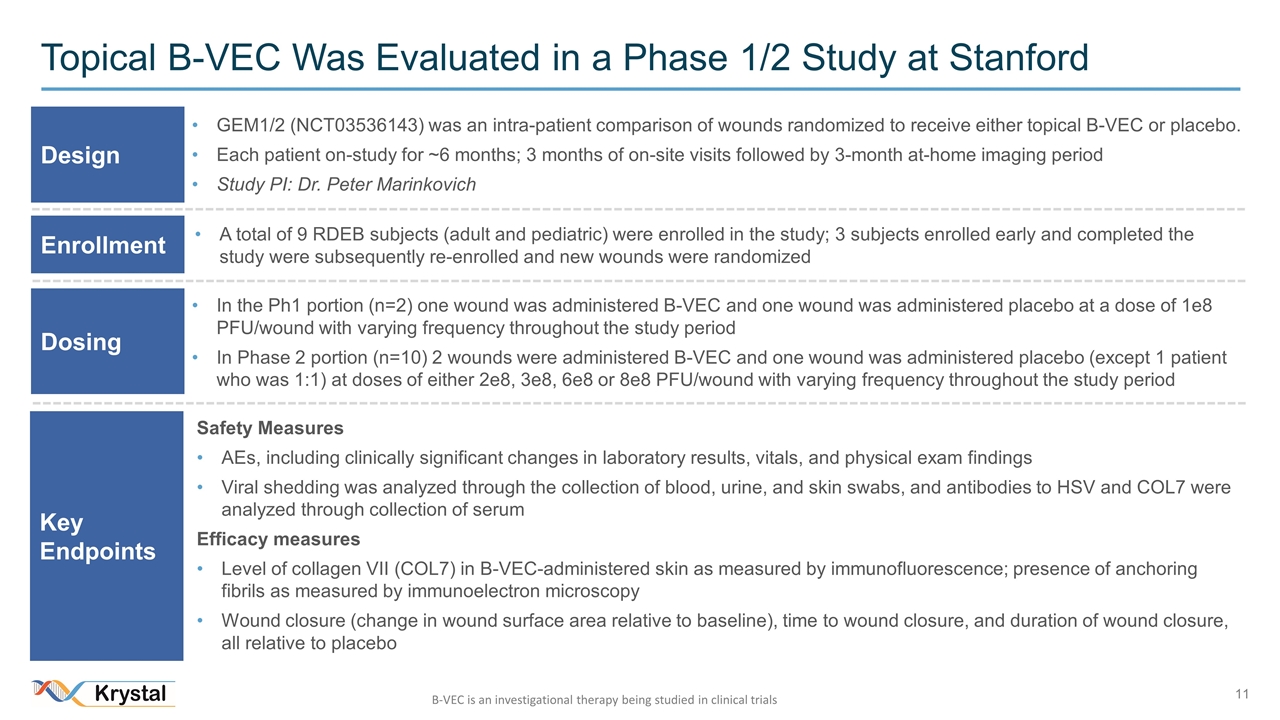
Topical B-VEC Was Evaluated in a Phase 1/2 Study at Stanford GEM1/2 (NCT03536143) was an intra-patient comparison of wounds randomized to receive either topical B-VEC or placebo. Each patient on-study for ~6 months; 3 months of on-site visits followed by 3-month at-home imaging period Study PI: Dr. Peter Marinkovich Design Enrollment Key Endpoints A total of 9 RDEB subjects (adult and pediatric) were enrolled in the study; 3 subjects enrolled early and completed the study were subsequently re-enrolled and new wounds were randomized Safety Measures AEs, including clinically significant changes in laboratory results, vitals, and physical exam findings Viral shedding was analyzed through the collection of blood, urine, and skin swabs, and antibodies to HSV and COL7 were analyzed through collection of serum Efficacy measures Level of collagen VII (COL7) in B-VEC-administered skin as measured by immunofluorescence; presence of anchoring fibrils as measured by immunoelectron microscopy Wound closure (change in wound surface area relative to baseline), time to wound closure, and duration of wound closure, all relative to placebo Dosing In the Ph1 portion (n=2) one wound was administered B-VEC and one wound was administered placebo at a dose of 1e8 PFU/wound with varying frequency throughout the study period In Phase 2 portion (n=10) 2 wounds were administered B-VEC and one wound was administered placebo (except 1 patient who was 1:1) at doses of either 2e8, 3e8, 6e8 or 8e8 PFU/wound with varying frequency throughout the study period B-VEC is an investigational therapy being studied in clinical trials
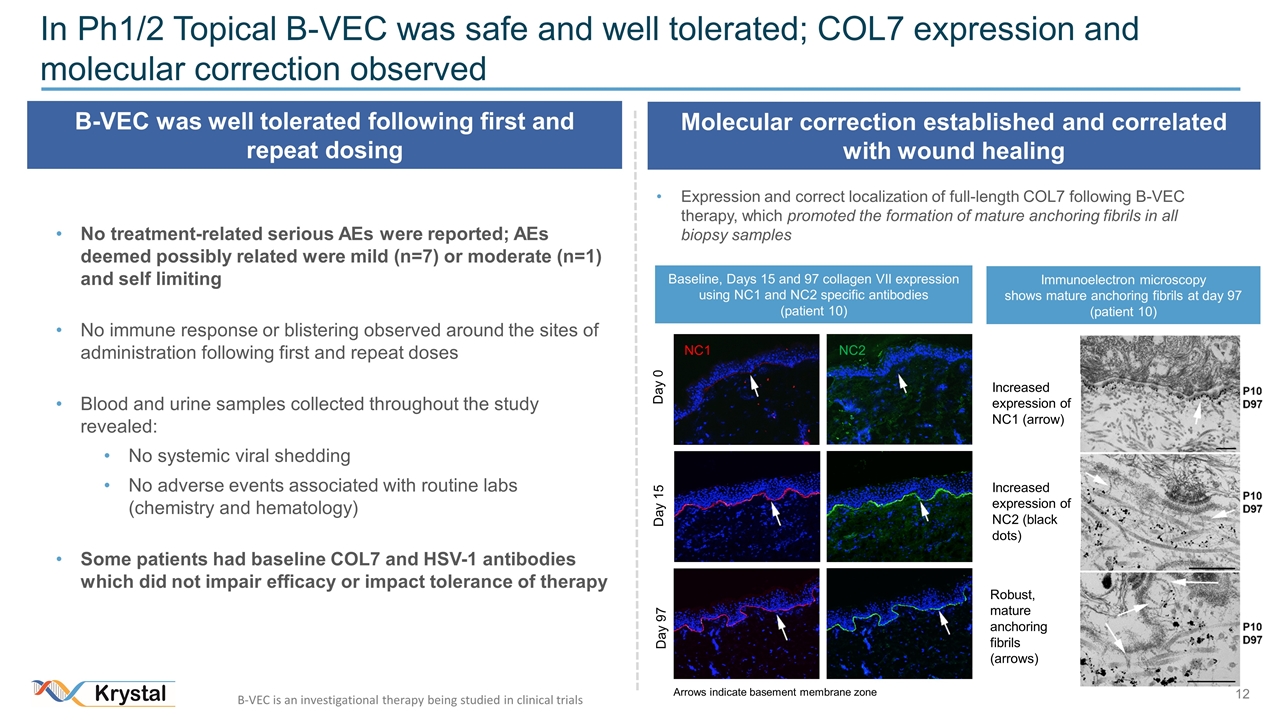
In Ph1/2 Topical B-VEC was safe and well tolerated; COL7 expression and molecular correction observed No treatment-related serious AEs were reported; AEs deemed possibly related were mild (n=7) or moderate (n=1) and self limiting No immune response or blistering observed around the sites of administration following first and repeat doses Blood and urine samples collected throughout the study revealed: No systemic viral shedding No adverse events associated with routine labs (chemistry and hematology) Some patients had baseline COL7 and HSV-1 antibodies which did not impair efficacy or impact tolerance of therapy B-VEC was well tolerated following first and repeat dosing Molecular correction established and correlated with wound healing Expression and correct localization of full-length COL7 following B-VEC therapy, which promoted the formation of mature anchoring fibrils in all biopsy samples Baseline, Days 15 and 97 collagen VII expression using NC1 and NC2 specific antibodies (patient 10) Immunoelectron microscopy shows mature anchoring fibrils at day 97 (patient 10) Day 0 Day 15 Day 97 NC1 NC2 Arrows indicate basement membrane zone Increased expression of NC1 (arrow) Increased expression of NC2 (black dots) Robust, mature anchoring fibrils (arrows) B-VEC is an investigational therapy being studied in clinical trials
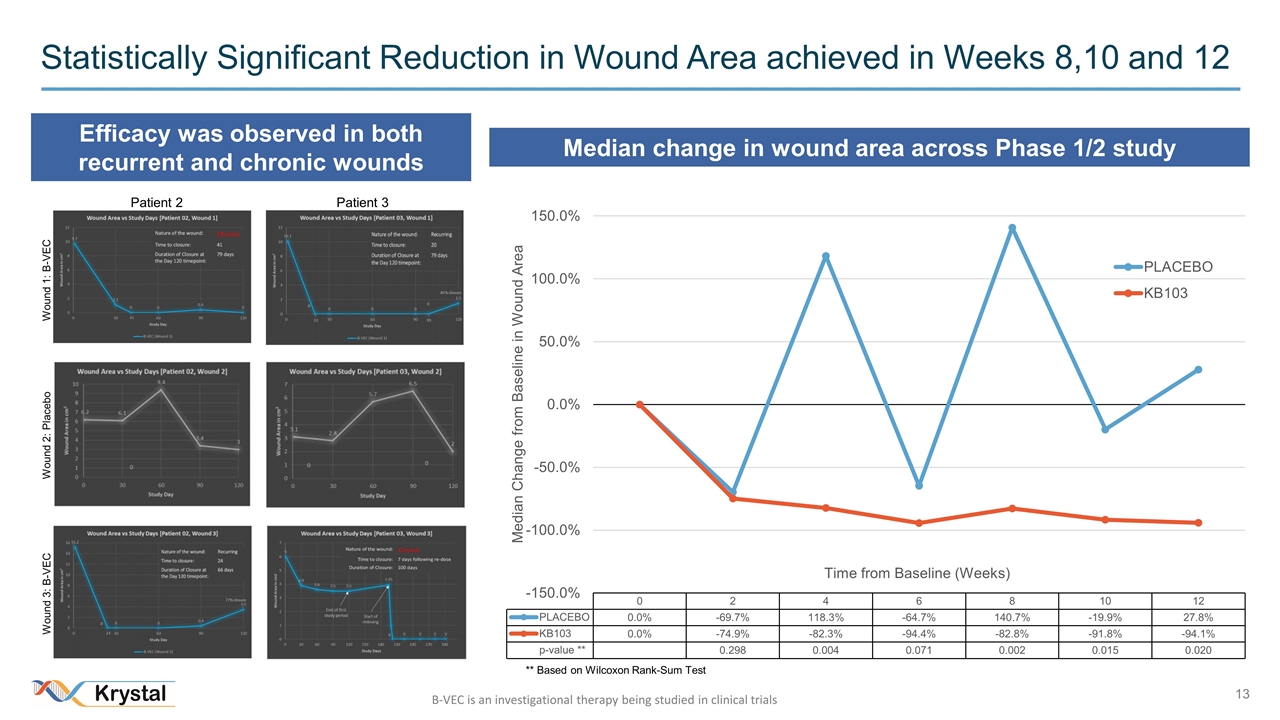
Statistically Significant Reduction in Wound Area achieved in Weeks 8,10 and 12 Efficacy was observed in both recurrent and chronic wounds Patient 2 Patient 3 Wound 1: B-VEC Wound 2: Placebo Wound 3: B-VEC Median change in wound area across Phase 1/2 study B-VEC is an investigational therapy being studied in clinical trials
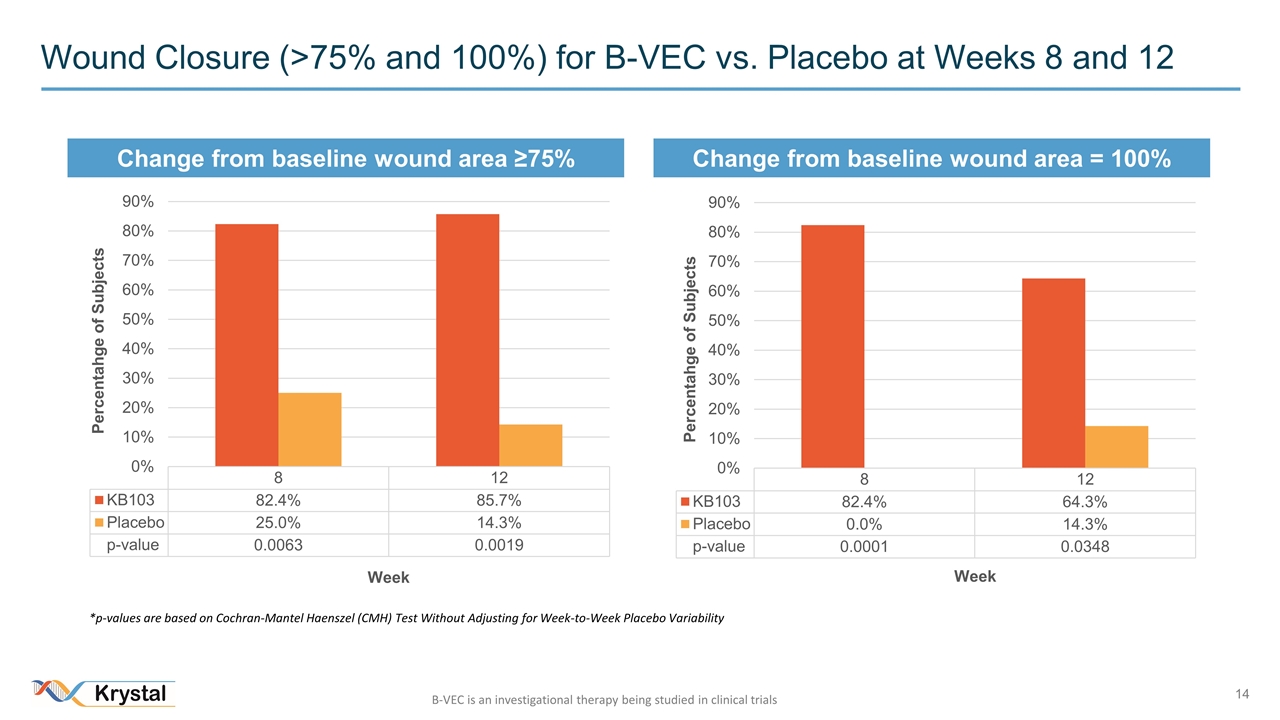
Wound Closure (>75% and 100%) for B-VEC vs. Placebo at Weeks 8 and 12 *p-values are based on Cochran-Mantel Haenszel (CMH) Test Without Adjusting for Week-to-Week Placebo Variability Change from baseline wound area ≥75% Change from baseline wound area = 100% B-VEC is an investigational therapy being studied in clinical trials
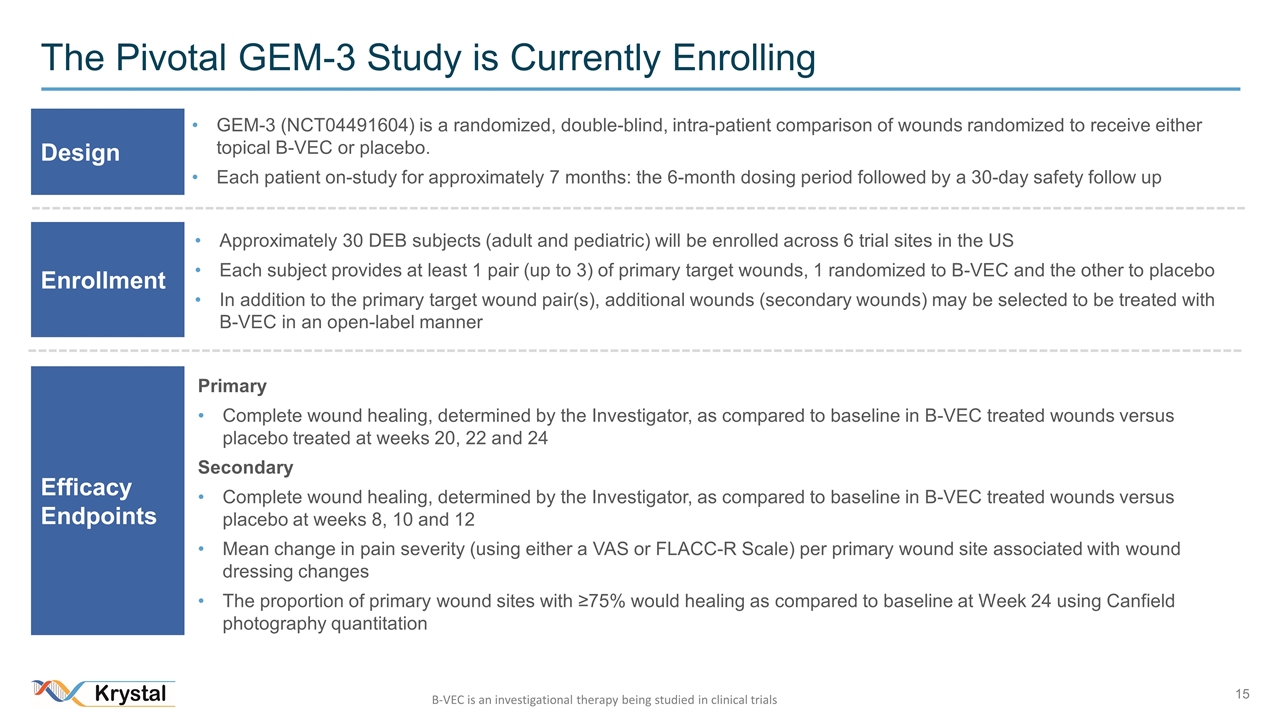
The Pivotal GEM-3 Study is Currently Enrolling GEM-3 (NCT04491604) is a randomized, double-blind, intra-patient comparison of wounds randomized to receive either topical B-VEC or placebo. Each patient on-study for approximately 7 months: the 6-month dosing period followed by a 30-day safety follow up Design Enrollment Efficacy Endpoints Approximately 30 DEB subjects (adult and pediatric) will be enrolled across 6 trial sites in the US Each subject provides at least 1 pair (up to 3) of primary target wounds, 1 randomized to B-VEC and the other to placebo In addition to the primary target wound pair(s), additional wounds (secondary wounds) may be selected to be treated with B-VEC in an open-label manner Primary Complete wound healing, determined by the Investigator, as compared to baseline in B-VEC treated wounds versus placebo treated at weeks 20, 22 and 24 Secondary Complete wound healing, determined by the Investigator, as compared to baseline in B-VEC treated wounds versus placebo at weeks 8, 10 and 12 Mean change in pain severity (using either a VAS or FLACC-R Scale) per primary wound site associated with wound dressing changes The proportion of primary wound sites with ≥75% would healing as compared to baseline at Week 24 using Canfield photography quantitation B-VEC is an investigational therapy being studied in clinical trials
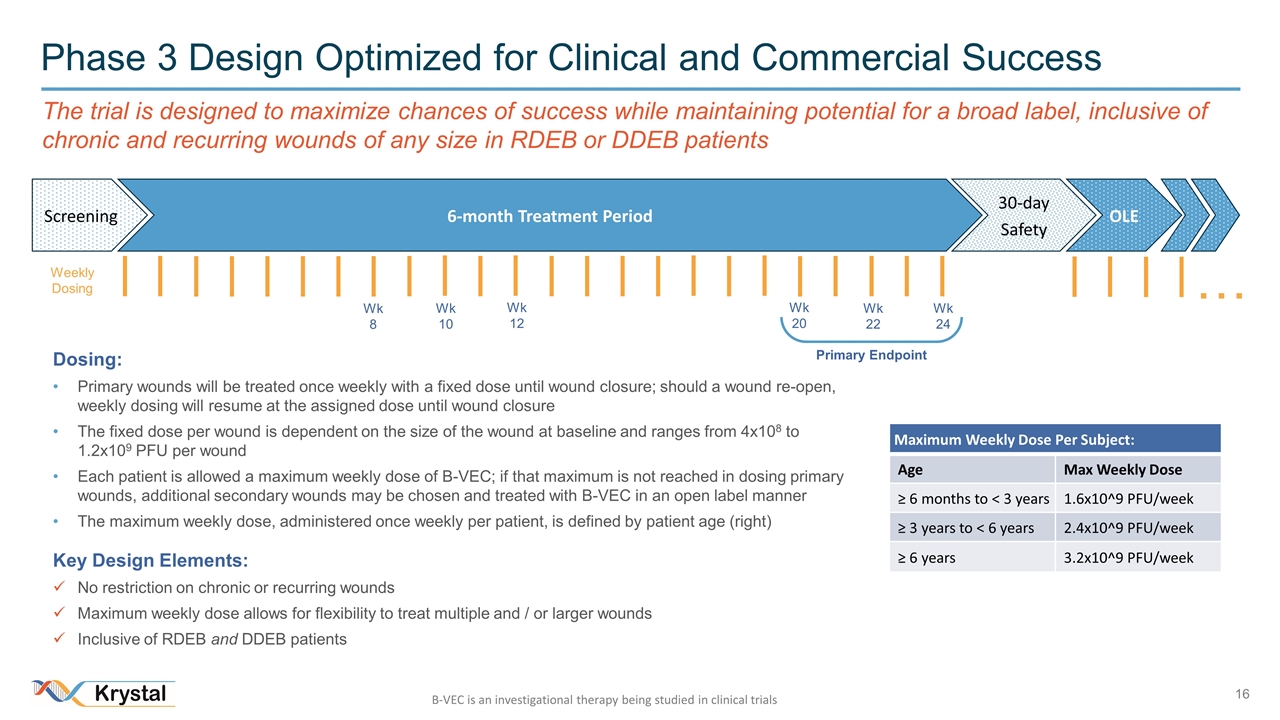
Phase 3 Design Optimized for Clinical and Commercial Success Screening 6-month Treatment Period 30-day Safety OLE Dosing: Primary wounds will be treated once weekly with a fixed dose until wound closure; should a wound re-open, weekly dosing will resume at the assigned dose until wound closure The fixed dose per wound is dependent on the size of the wound at baseline and ranges from 4x108 to 1.2x109 PFU per wound Each patient is allowed a maximum weekly dose of B-VEC; if that maximum is not reached in dosing primary wounds, additional secondary wounds may be chosen and treated with B-VEC in an open label manner The maximum weekly dose, administered once weekly per patient, is defined by patient age (right) Wk 20 Wk 22 Wk 24 Wk 8 Wk 10 Wk 12 Maximum Weekly Dose Per Subject: Age Max Weekly Dose ≥ 6 months to < 3 years 1.6x10^9 PFU/week ≥ 3 years to < 6 years 2.4x10^9 PFU/week ≥ 6 years 3.2x10^9 PFU/week … The trial is designed to maximize chances of success while maintaining potential for a broad label, inclusive of chronic and recurring wounds of any size in RDEB or DDEB patients Key Design Elements: No restriction on chronic or recurring wounds Maximum weekly dose allows for flexibility to treat multiple and / or larger wounds Inclusive of RDEB and DDEB patients Primary Endpoint Weekly Dosing B-VEC is an investigational therapy being studied in clinical trials
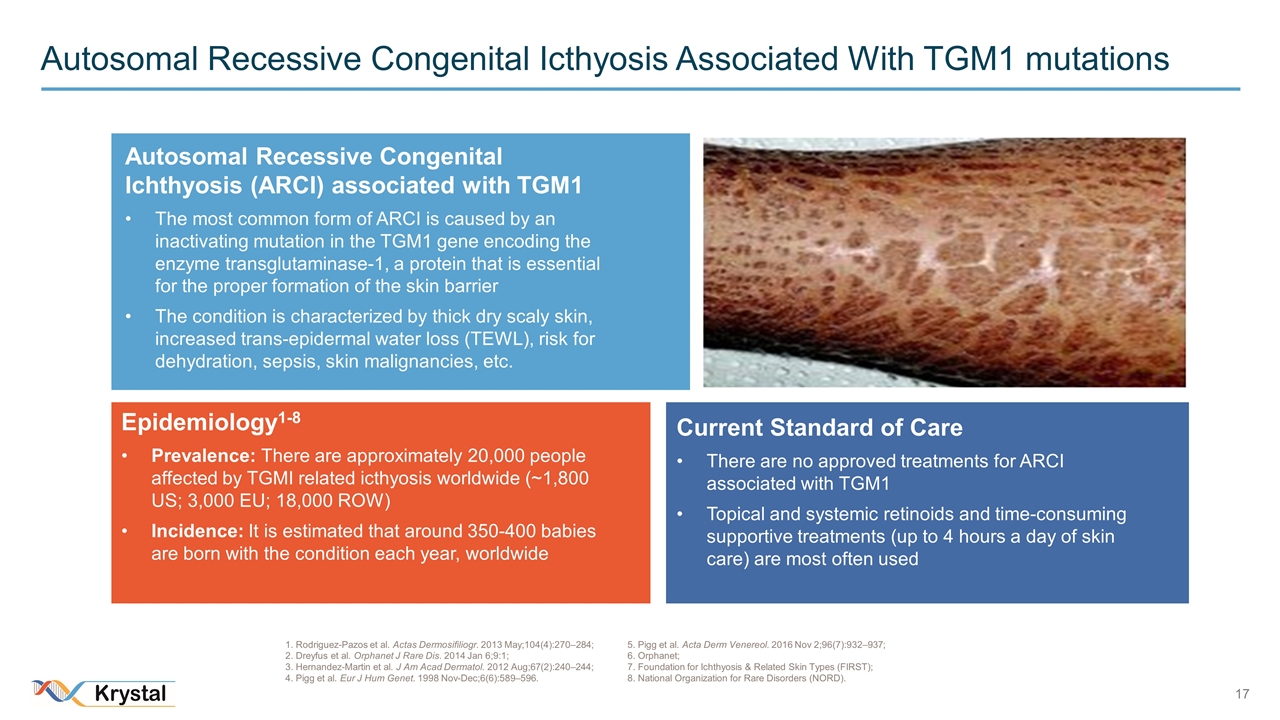
Autosomal Recessive Congenital Icthyosis Associated With TGM1 mutations Autosomal Recessive Congenital Ichthyosis (ARCI) associated with TGM1 The most common form of ARCI is caused by an inactivating mutation in the TGM1 gene encoding the enzyme transglutaminase-1, a protein that is essential for the proper formation of the skin barrier The condition is characterized by thick dry scaly skin, increased trans-epidermal water loss (TEWL), risk for dehydration, sepsis, skin malignancies, etc. Epidemiology1-8 Prevalence: There are approximately 20,000 people affected by TGMI related icthyosis worldwide (~1,800 US; 3,000 EU; 18,000 ROW) Incidence: It is estimated that around 350-400 babies are born with the condition each year, worldwide Current Standard of Care There are no approved treatments for ARCI associated with TGM1 Topical and systemic retinoids and time-consuming supportive treatments (up to 4 hours a day of skin care) are most often used 1. Rodriguez-Pazos et al. Actas Dermosifiliogr. 2013 May;104(4):270–284; 2. Dreyfus et al. Orphanet J Rare Dis. 2014 Jan 6;9:1; 3. Hernandez-Martin et al. J Am Acad Dermatol. 2012 Aug;67(2):240–244; 4. Pigg et al. Eur J Hum Genet. 1998 Nov-Dec;6(6):589–596. 5. Pigg et al. Acta Derm Venereol. 2016 Nov 2;96(7):932–937; 6. Orphanet; 7. Foundation for Ichthyosis & Related Skin Types (FIRST); 8. National Organization for Rare Disorders (NORD).
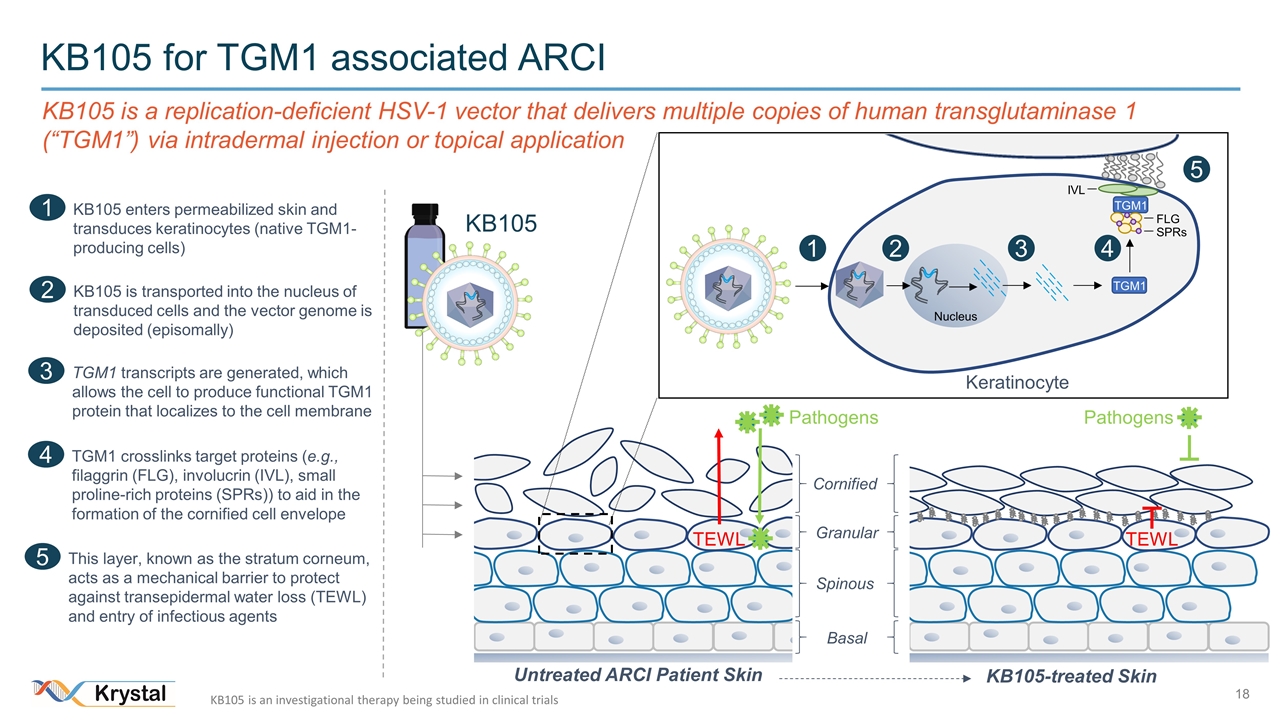
KB105 for TGM1 associated ARCI KB105 is a replication-deficient HSV-1 vector that delivers multiple copies of human transglutaminase 1 (“TGM1”) via intradermal injection or topical application 3 TGM1 transcripts are generated, which allows the cell to produce functional TGM1 protein that localizes to the cell membrane 2 KB105 is transported into the nucleus of transduced cells and the vector genome is deposited (episomally) 1 KB105 enters permeabilized skin and transduces keratinocytes (native TGM1-producing cells) 4 TGM1 crosslinks target proteins (e.g., filaggrin (FLG), involucrin (IVL), small proline-rich proteins (SPRs)) to aid in the formation of the cornified cell envelope 5 This layer, known as the stratum corneum, acts as a mechanical barrier to protect against transepidermal water loss (TEWL) and entry of infectious agents Untreated ARCI Patient Skin KB105-treated Skin 1 2 3 Nucleus Keratinocyte 5 4 TGM1 SPRs FLG IVL TGM1 Basal Spinous Granular Cornified TEWL TEWL Pathogens Pathogens KB105 KB105 is an investigational therapy being studied in clinical trials
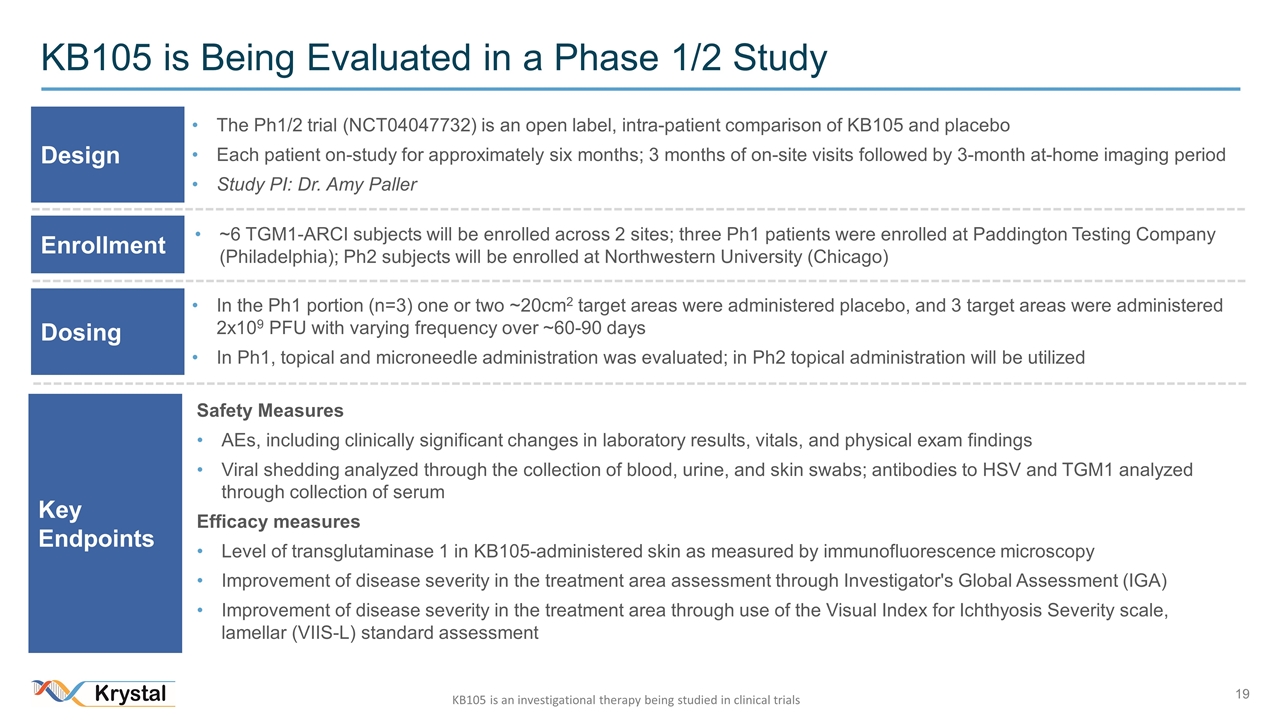
KB105 is Being Evaluated in a Phase 1/2 Study The Ph1/2 trial (NCT04047732) is an open label, intra-patient comparison of KB105 and placebo Each patient on-study for approximately six months; 3 months of on-site visits followed by 3-month at-home imaging period Study PI: Dr. Amy Paller Design Enrollment Key Endpoints ~6 TGM1-ARCI subjects will be enrolled across 2 sites; three Ph1 patients were enrolled at Paddington Testing Company (Philadelphia); Ph2 subjects will be enrolled at Northwestern University (Chicago) Safety Measures AEs, including clinically significant changes in laboratory results, vitals, and physical exam findings Viral shedding analyzed through the collection of blood, urine, and skin swabs; antibodies to HSV and TGM1 analyzed through collection of serum Efficacy measures Level of transglutaminase 1 in KB105-administered skin as measured by immunofluorescence microscopy Improvement of disease severity in the treatment area assessment through Investigator's Global Assessment (IGA) Improvement of disease severity in the treatment area through use of the Visual Index for Ichthyosis Severity scale, lamellar (VIIS-L) standard assessment Dosing In the Ph1 portion (n=3) one or two ~20cm2 target areas were administered placebo, and 3 target areas were administered 2x109 PFU with varying frequency over ~60-90 days In Ph1, topical and microneedle administration was evaluated; in Ph2 topical administration will be utilized KB105 is an investigational therapy being studied in clinical trials
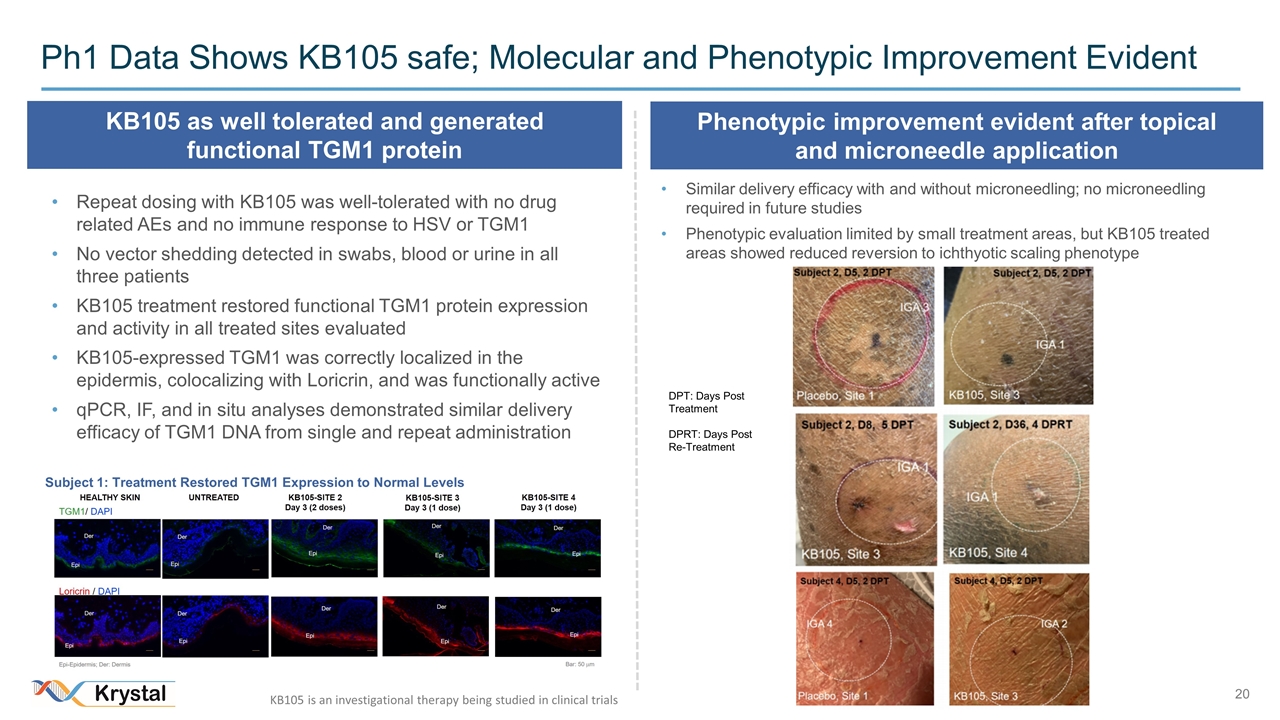
Ph1 Data Shows KB105 safe; Molecular and Phenotypic Improvement Evident Repeat dosing with KB105 was well-tolerated with no drug related AEs and no immune response to HSV or TGM1 No vector shedding detected in swabs, blood or urine in all three patients KB105 treatment restored functional TGM1 protein expression and activity in all treated sites evaluated KB105-expressed TGM1 was correctly localized in the epidermis, colocalizing with Loricrin, and was functionally active qPCR, IF, and in situ analyses demonstrated similar delivery efficacy of TGM1 DNA from single and repeat administration KB105 as well tolerated and generated functional TGM1 protein Phenotypic improvement evident after topical and microneedle application Similar delivery efficacy with and without microneedling; no microneedling required in future studies Phenotypic evaluation limited by small treatment areas, but KB105 treated areas showed reduced reversion to ichthyotic scaling phenotype DPT: Days Post Treatment DPRT: Days Post Re-Treatment Subject 1: Treatment Restored TGM1 Expression to Normal Levels KB105 is an investigational therapy being studied in clinical trials
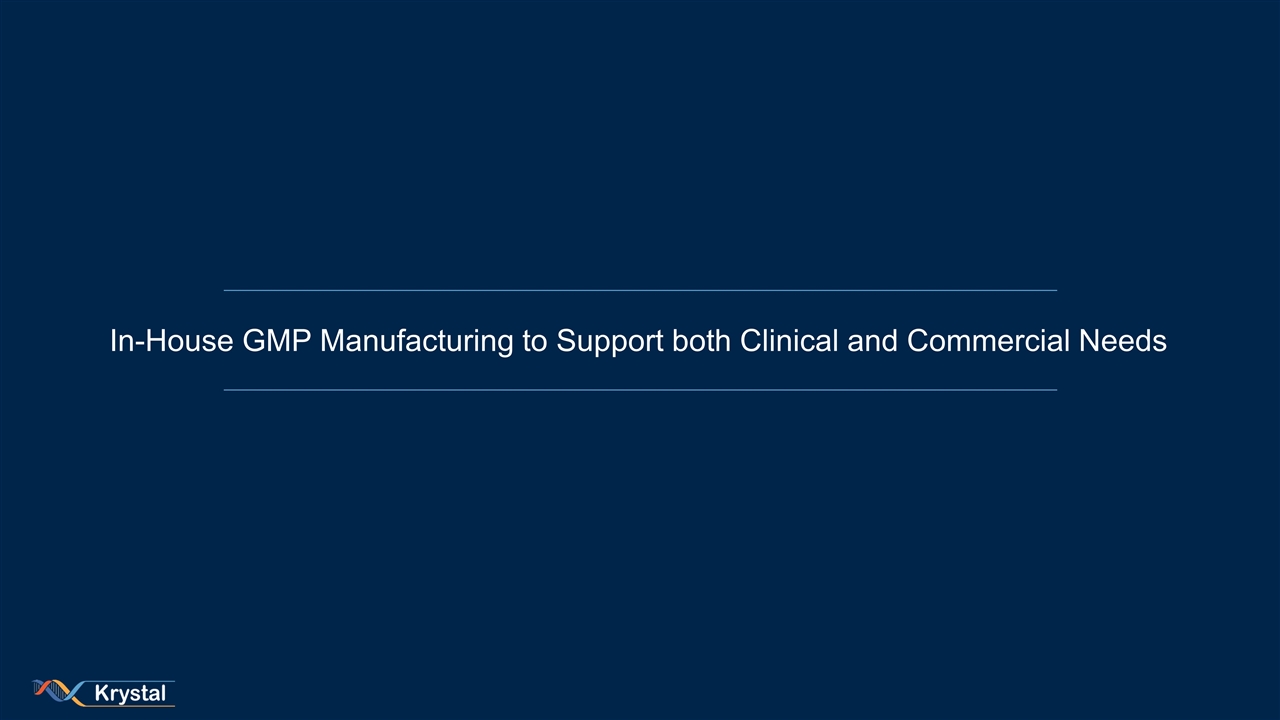
In-House GMP Manufacturing to Support both Clinical and Commercial Needs
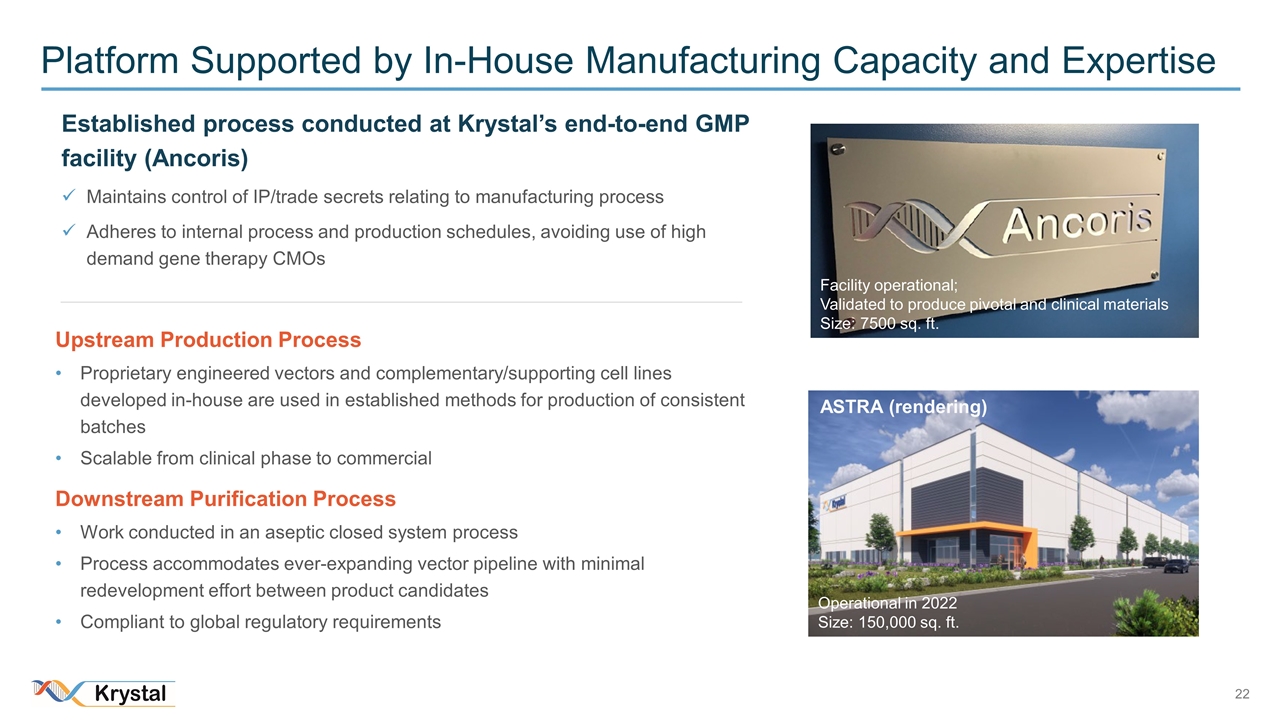
Established process conducted at Krystal’s end-to-end GMP facility (Ancoris) Maintains control of IP/trade secrets relating to manufacturing process Adheres to internal process and production schedules, avoiding use of high demand gene therapy CMOs Platform Supported by In-House Manufacturing Capacity and Expertise Upstream Production Process Proprietary engineered vectors and complementary/supporting cell lines developed in-house are used in established methods for production of consistent batches Scalable from clinical phase to commercial Downstream Purification Process Work conducted in an aseptic closed system process Process accommodates ever-expanding vector pipeline with minimal redevelopment effort between product candidates Compliant to global regulatory requirements Facility operational; Validated to produce pivotal and clinical materials Size: 7500 sq. ft. ASTRA (rendering) Operational in 2022 Size: 150,000 sq. ft.
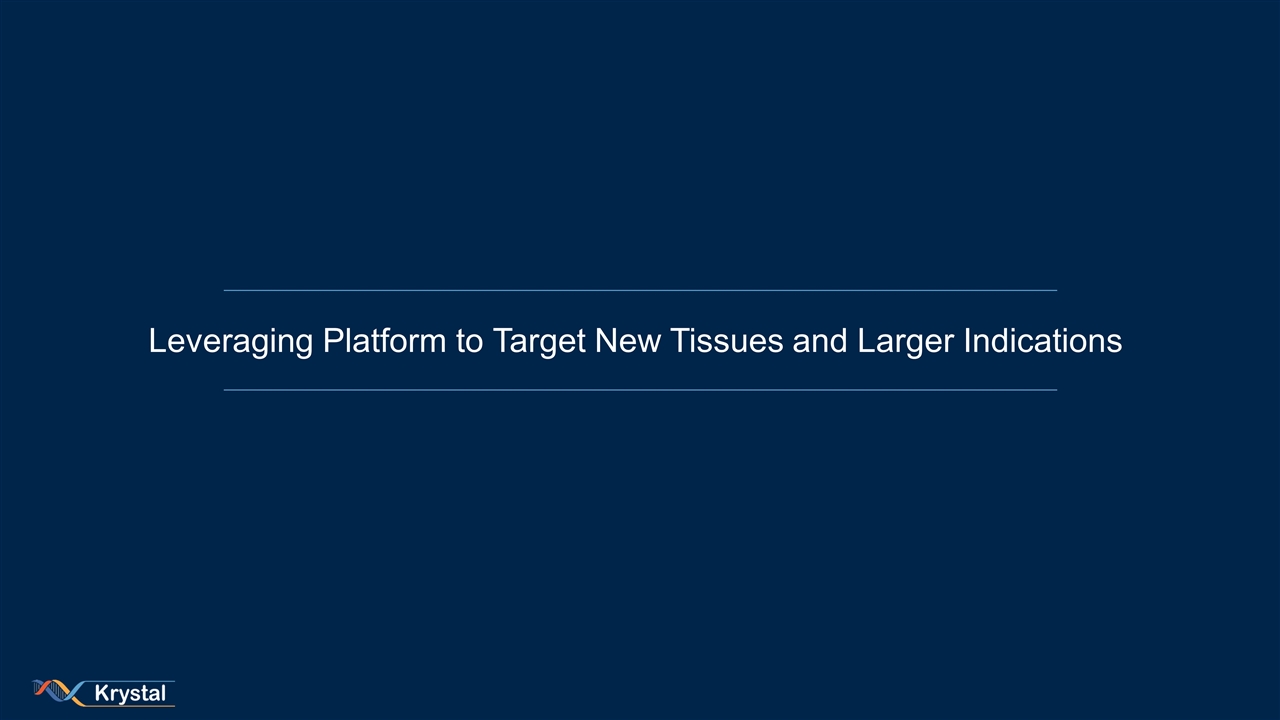
Leveraging Platform to Target New Tissues and Larger Indications
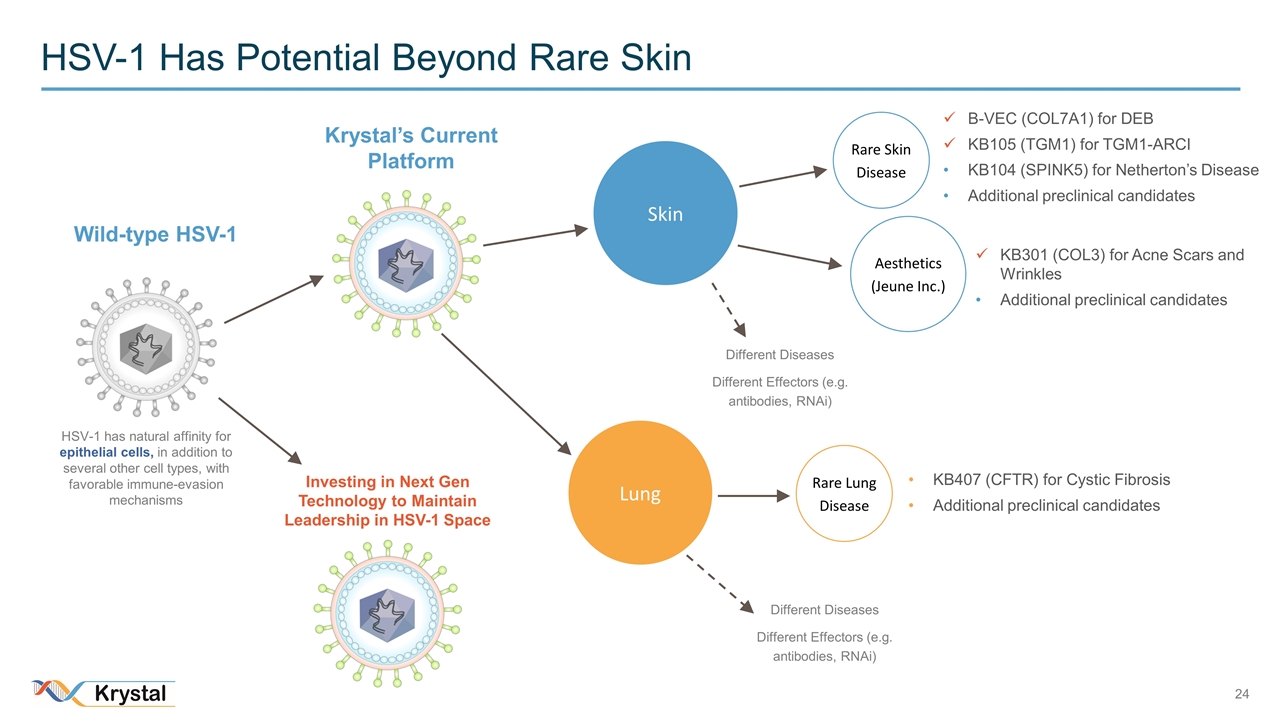
HSV-1 Has Potential Beyond Rare Skin B-VEC (COL7A1) for DEB KB105 (TGM1) for TGM1-ARCI KB104 (SPINK5) for Netherton’s Disease Additional preclinical candidates Wild-type HSV-1 Krystal’s Current Platform HSV-1 has natural affinity for epithelial cells, in addition to several other cell types, with favorable immune-evasion mechanisms Investing in Next Gen Technology to Maintain Leadership in HSV-1 Space Skin Rare Skin Disease Aesthetics (Jeune Inc.) KB301 (COL3) for Acne Scars and Wrinkles Additional preclinical candidates Lung Rare Lung Disease Different Diseases Different Effectors (e.g. antibodies, RNAi) KB407 (CFTR) for Cystic Fibrosis Additional preclinical candidates Different Diseases Different Effectors (e.g. antibodies, RNAi)
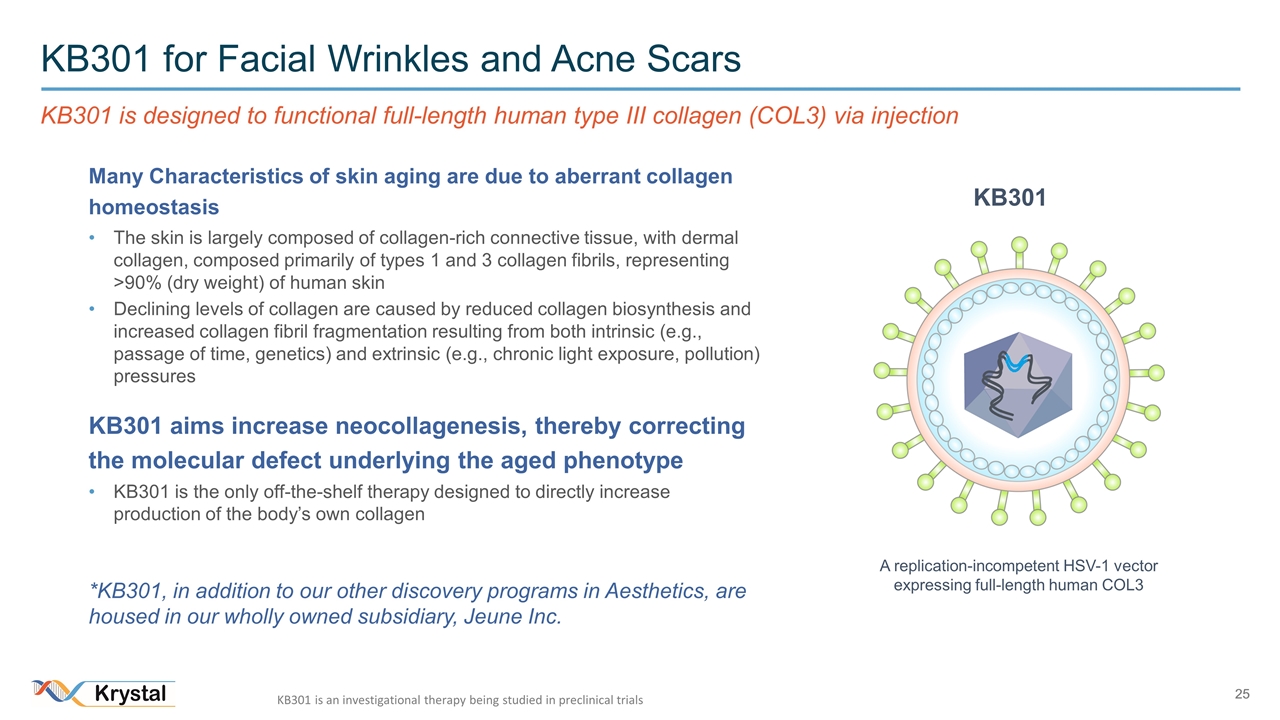
KB301 is designed to functional full-length human type III collagen (COL3) via injection KB301 for Facial Wrinkles and Acne Scars Many Characteristics of skin aging are due to aberrant collagen homeostasis The skin is largely composed of collagen-rich connective tissue, with dermal collagen, composed primarily of types 1 and 3 collagen fibrils, representing >90% (dry weight) of human skin Declining levels of collagen are caused by reduced collagen biosynthesis and increased collagen fibril fragmentation resulting from both intrinsic (e.g., passage of time, genetics) and extrinsic (e.g., chronic light exposure, pollution) pressures KB301 aims increase neocollagenesis, thereby correcting the molecular defect underlying the aged phenotype KB301 is the only off-the-shelf therapy designed to directly increase production of the body’s own collagen *KB301, in addition to our other discovery programs in Aesthetics, are housed in our wholly owned subsidiary, Jeune Inc. KB301 is an investigational therapy being studied in preclinical trials KB301 A replication-incompetent HSV-1 vector expressing full-length human COL3
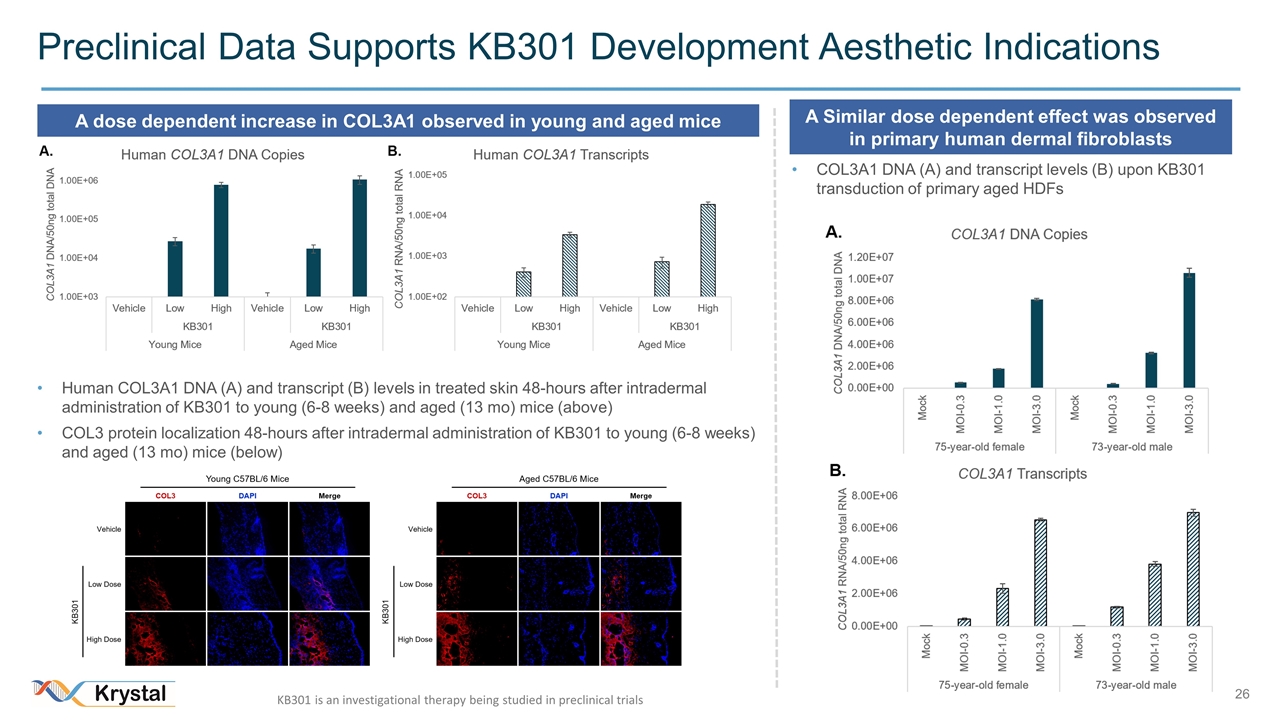
Preclinical Data Supports KB301 Development Aesthetic Indications A dose dependent increase in COL3A1 observed in young and aged mice A Similar dose dependent effect was observed in primary human dermal fibroblasts KB301 is an investigational therapy being studied in preclinical trials Human COL3A1 DNA (A) and transcript (B) levels in treated skin 48-hours after intradermal administration of KB301 to young (6-8 weeks) and aged (13 mo) mice (above) COL3 protein localization 48-hours after intradermal administration of KB301 to young (6-8 weeks) and aged (13 mo) mice (below) COL3A1 DNA (A) and transcript levels (B) upon KB301 transduction of primary aged HDFs
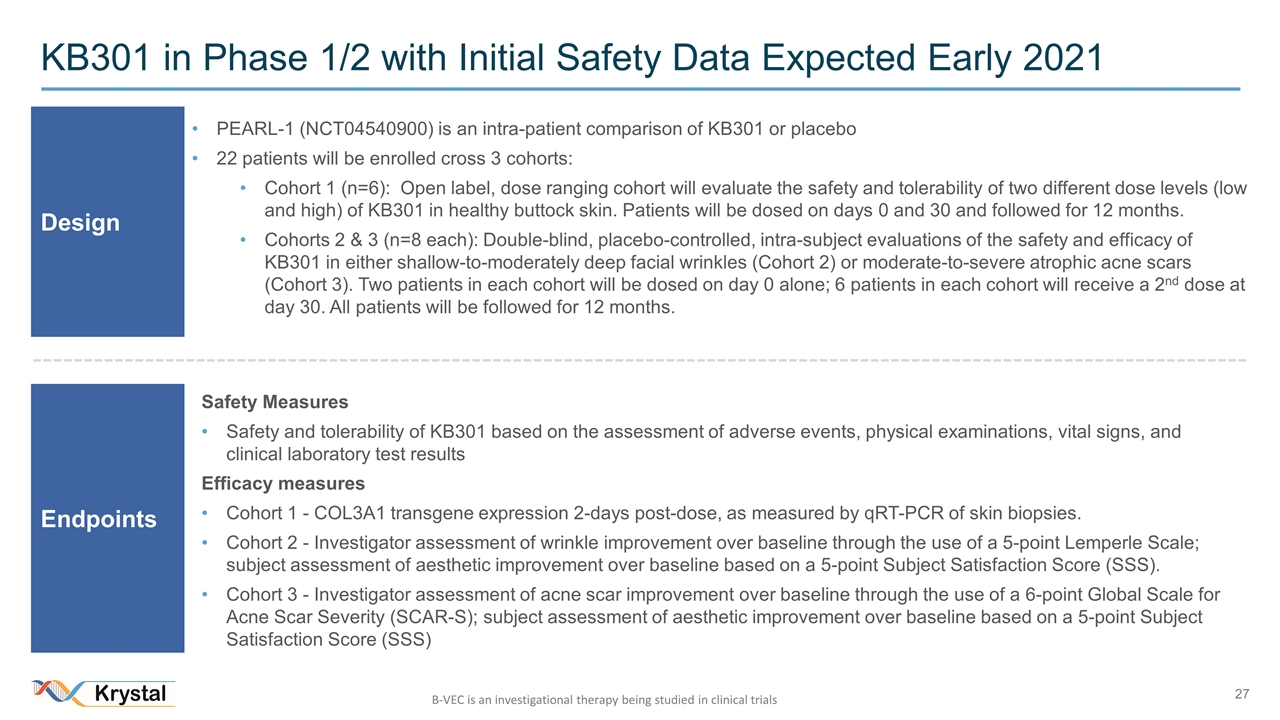
KB301 in Phase 1/2 with Initial Safety Data Expected Early 2021 PEARL-1 (NCT04540900) is an intra-patient comparison of KB301 or placebo 22 patients will be enrolled cross 3 cohorts: Cohort 1 (n=6): Open label, dose ranging cohort will evaluate the safety and tolerability of two different dose levels (low and high) of KB301 in healthy buttock skin. Patients will be dosed on days 0 and 30 and followed for 12 months. Cohorts 2 & 3 (n=8 each): Double-blind, placebo-controlled, intra-subject evaluations of the safety and efficacy of KB301 in either shallow-to-moderately deep facial wrinkles (Cohort 2) or moderate-to-severe atrophic acne scars (Cohort 3). Two patients in each cohort will be dosed on day 0 alone; 6 patients in each cohort will receive a 2nd dose at day 30. All patients will be followed for 12 months. Design Endpoints Safety Measures Safety and tolerability of KB301 based on the assessment of adverse events, physical examinations, vital signs, and clinical laboratory test results Efficacy measures Cohort 1 - COL3A1 transgene expression 2-days post-dose, as measured by qRT-PCR of skin biopsies. Cohort 2 - Investigator assessment of wrinkle improvement over baseline through the use of a 5-point Lemperle Scale; subject assessment of aesthetic improvement over baseline based on a 5-point Subject Satisfaction Score (SSS). Cohort 3 - Investigator assessment of acne scar improvement over baseline through the use of a 6-point Global Scale for Acne Scar Severity (SCAR-S); subject assessment of aesthetic improvement over baseline based on a 5-point Subject Satisfaction Score (SSS) B-VEC is an investigational therapy being studied in clinical trials
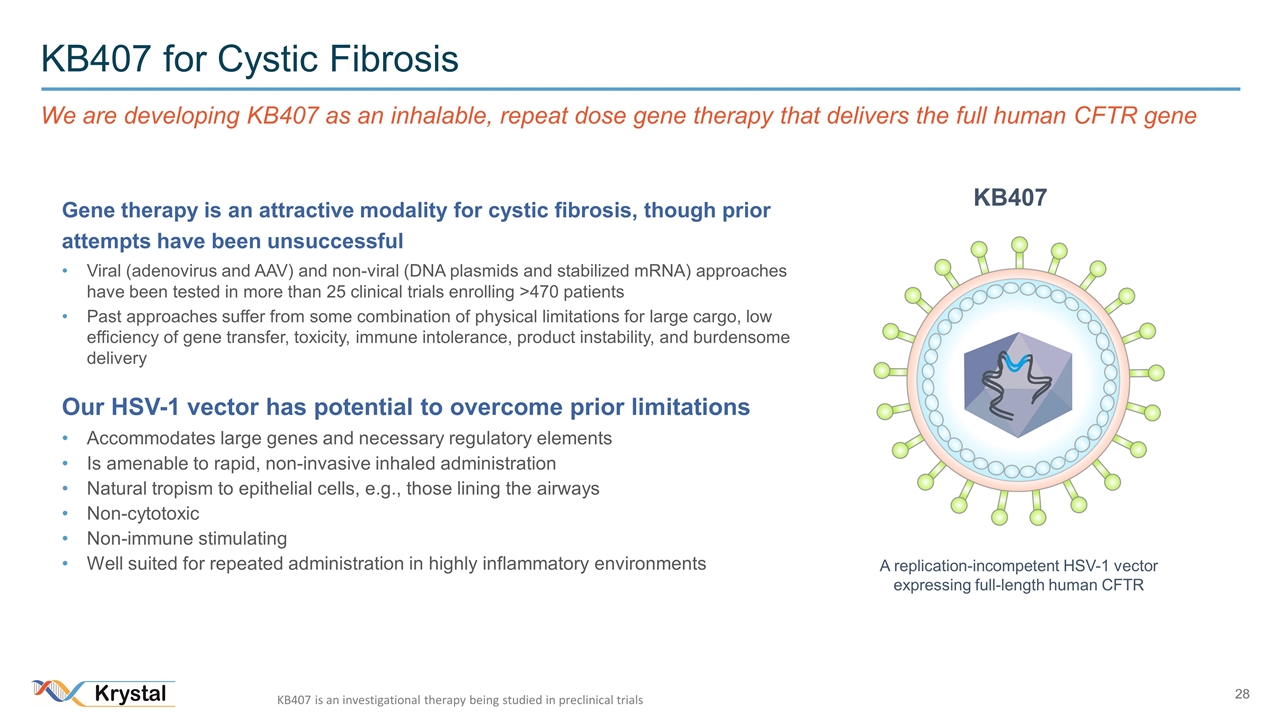
We are developing KB407 as an inhalable, repeat dose gene therapy that delivers the full human CFTR gene KB407 for Cystic Fibrosis Gene therapy is an attractive modality for cystic fibrosis, though prior attempts have been unsuccessful Viral (adenovirus and AAV) and non-viral (DNA plasmids and stabilized mRNA) approaches have been tested in more than 25 clinical trials enrolling >470 patients Past approaches suffer from some combination of physical limitations for large cargo, low efficiency of gene transfer, toxicity, immune intolerance, product instability, and burdensome delivery Our HSV-1 vector has potential to overcome prior limitations Accommodates large genes and necessary regulatory elements Is amenable to rapid, non-invasive inhaled administration Natural tropism to epithelial cells, e.g., those lining the airways Non-cytotoxic Non-immune stimulating Well suited for repeated administration in highly inflammatory environments KB407 A replication-incompetent HSV-1 vector expressing full-length human CFTR KB407 is an investigational therapy being studied in preclinical trials
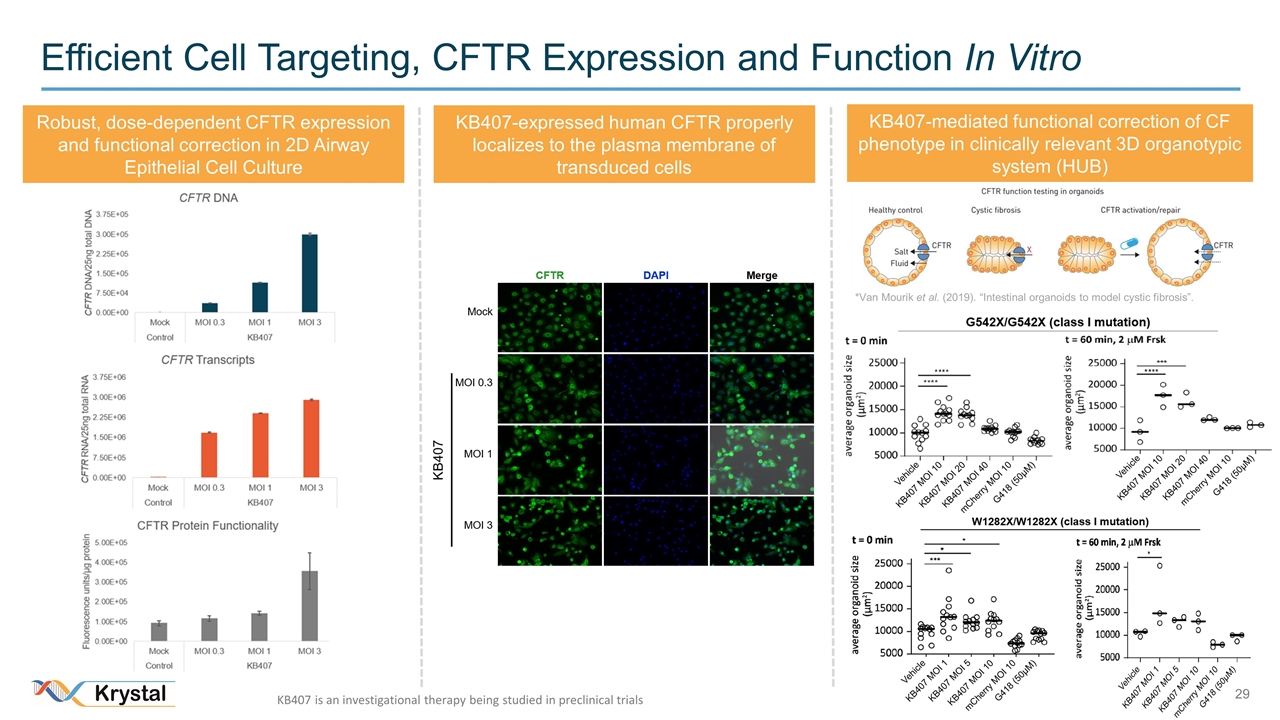
Efficient Cell Targeting, CFTR Expression and Function In Vitro Robust, dose-dependent CFTR expression and functional correction in 2D Airway Epithelial Cell Culture KB407-expressed human CFTR properly localizes to the plasma membrane of transduced cells KB407-mediated functional correction of CF phenotype in clinically relevant 3D organotypic system (HUB) *Van Mourik et al. (2019). “Intestinal organoids to model cystic fibrosis”. KB407 is an investigational therapy being studied in preclinical trials
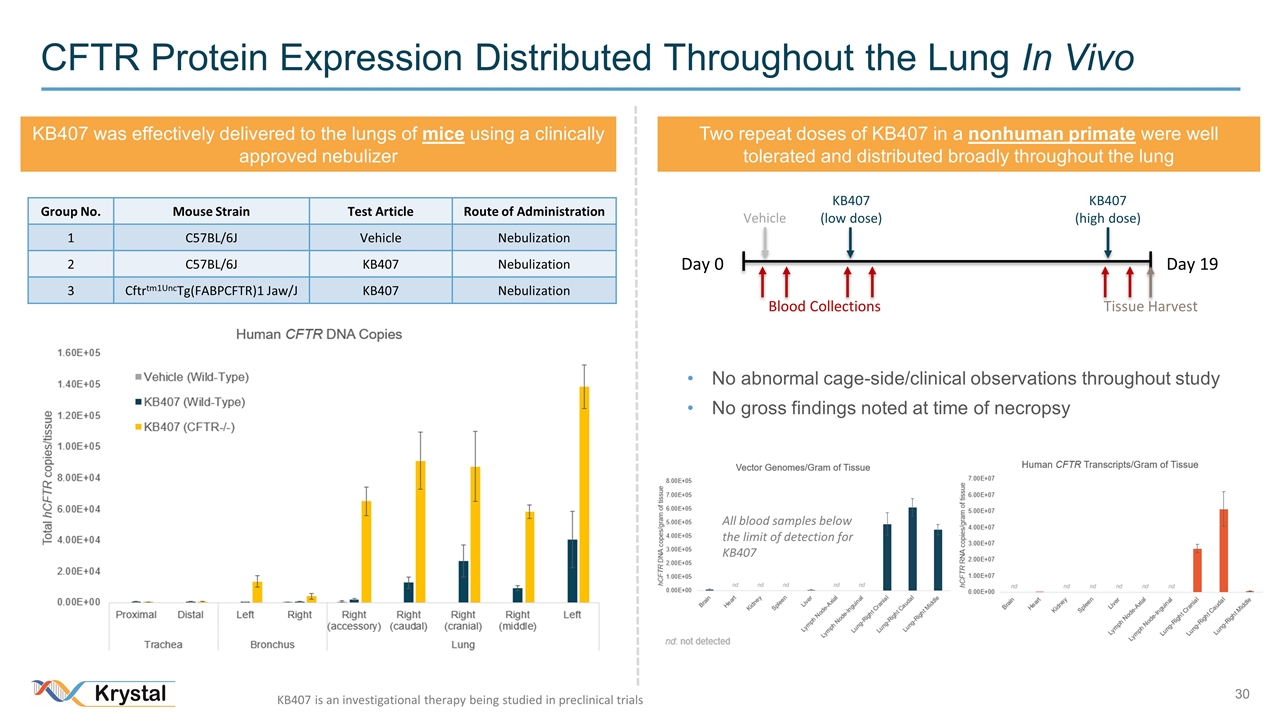
CFTR Protein Expression Distributed Throughout the Lung In Vivo KB407 was effectively delivered to the lungs of mice using a clinically approved nebulizer Two repeat doses of KB407 in a nonhuman primate were well tolerated and distributed broadly throughout the lung Group No. Mouse Strain Test Article Route of Administration 1 C57BL/6J Vehicle Nebulization 2 C57BL/6J KB407 Nebulization 3 Cftrtm1UncTg(FABPCFTR)1 Jaw/J KB407 Nebulization Day 0 Day 19 Blood Collections Vehicle KB407 (low dose) KB407 (high dose) Tissue Harvest All blood samples below the limit of detection for KB407 No abnormal cage-side/clinical observations throughout study No gross findings noted at time of necropsy KB407 is an investigational therapy being studied in preclinical trials

Financials and Milestones
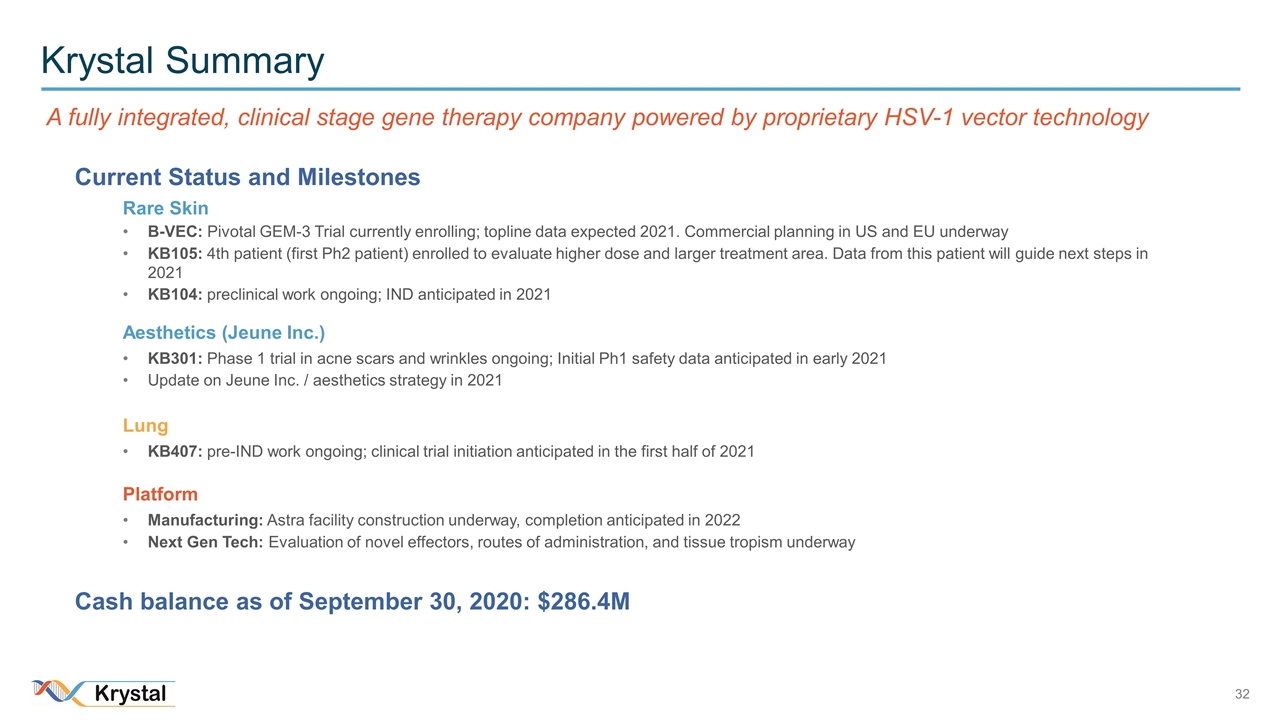
A fully integrated, clinical stage gene therapy company powered by proprietary HSV-1 vector technology Krystal Summary Current Status and Milestones Rare Skin B-VEC: Pivotal GEM-3 Trial currently enrolling; topline data expected 2021. Commercial planning in US and EU underway KB105: 4th patient (first Ph2 patient) enrolled to evaluate higher dose and larger treatment area. Data from this patient will guide next steps in 2021 KB104: preclinical work ongoing; IND anticipated in 2021 Aesthetics (Jeune Inc.) KB301: Phase 1 trial in acne scars and wrinkles ongoing; Initial Ph1 safety data anticipated in early 2021 Update on Jeune Inc. / aesthetics strategy in 2021 Lung KB407: pre-IND work ongoing; clinical trial initiation anticipated in the first half of 2021 Platform Manufacturing: Astra facility construction underway, completion anticipated in 2022 Next Gen Tech: Evaluation of novel effectors, routes of administration, and tissue tropism underway Cash balance as of September 30, 2020: $286.4M
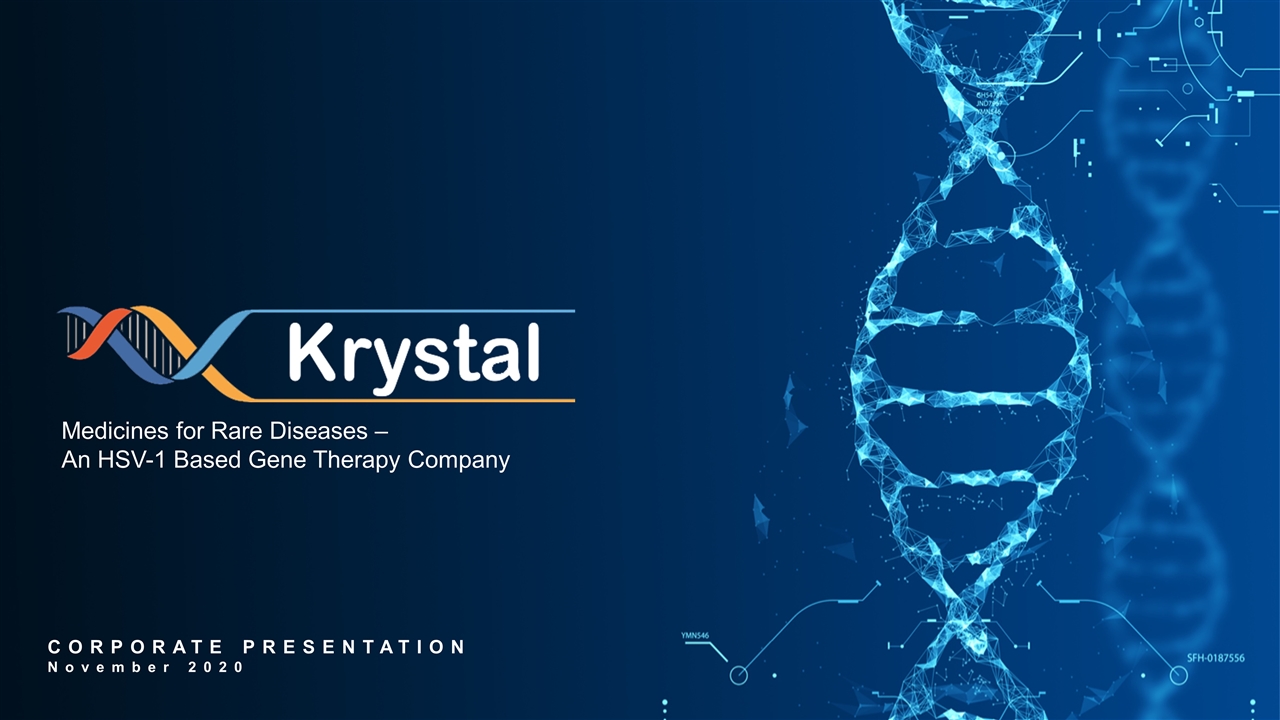
Medicines for Rare Diseases – An HSV-1 Based Gene Therapy Company CORPORATE PRESENTATION November 2020
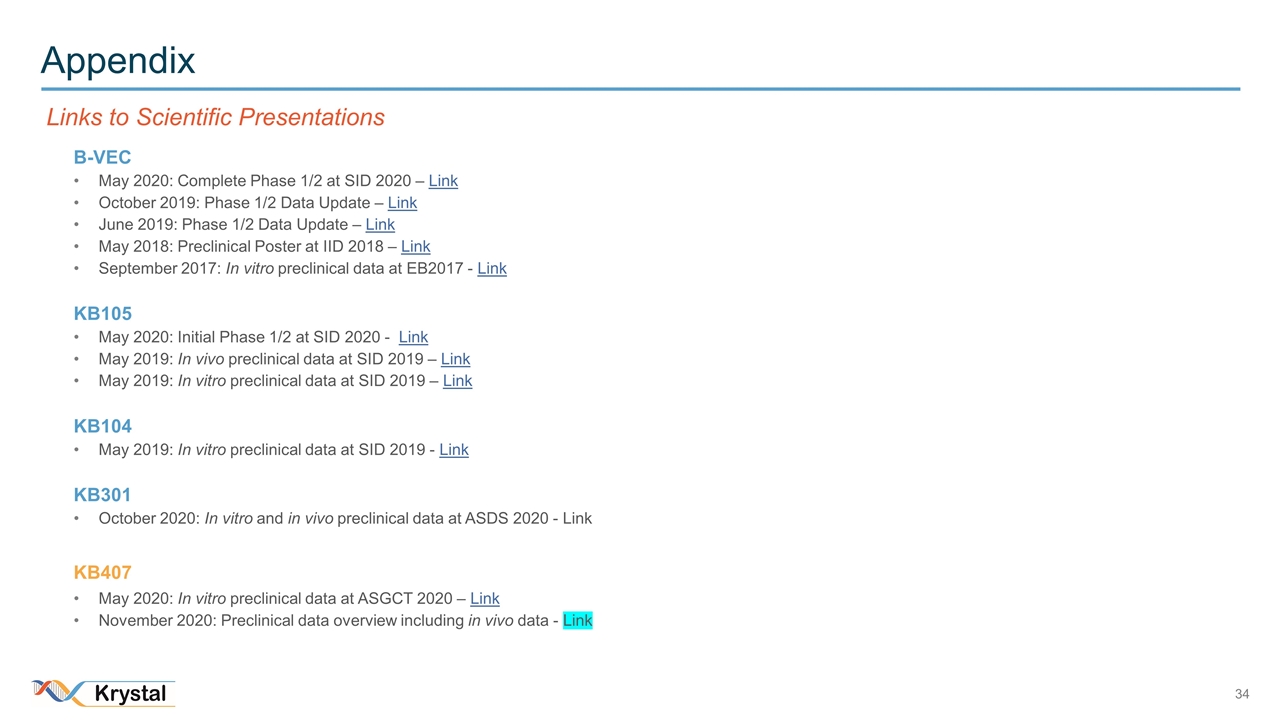
Links to Scientific Presentations Appendix B-VEC May 2020: Complete Phase 1/2 at SID 2020 – Link October 2019: Phase 1/2 Data Update – Link June 2019: Phase 1/2 Data Update – Link May 2018: Preclinical Poster at IID 2018 – Link September 2017: In vitro preclinical data at EB2017 - Link KB105 May 2020: Initial Phase 1/2 at SID 2020 - Link May 2019: In vivo preclinical data at SID 2019 – Link May 2019: In vitro preclinical data at SID 2019 – Link KB104 May 2019: In vitro preclinical data at SID 2019 - Link KB301 October 2020: In vitro and in vivo preclinical data at ASDS 2020 - Link KB407 May 2020: In vitro preclinical data at ASGCT 2020 – Link November 2020: Preclinical data overview including in vivo data - Link
